Worst food inflation since 2022. Worst housing inflation in months. But plunging prices for lodging, rental cars, and airfares are interesting.
By Wolf Richter for WOLF STREET.
In the Consumer Price Index today, month-to-month inflation accelerated further for housing, food, medical care services, and motor vehicle maintenance and repair, showing the worst increases in many months, and in the case of food, in years.
But these price increases were overpowered by plunging gasoline prices, and by plunging prices in the travel sector – month-to-month not annualized: lodging away from home (-3.5%), airline fares (-5.3%), and rental cars (-2.7%). These are huge month-to-month drops, annualized between -28% and -48%.
In addition, prices dropped month-to-month not annualized for motor vehicle insurance (-0.8%), used vehicles (-0.7%), and sporting goods (-0.6%). All seasonally adjusted.
As a result, overall CPI turned negative month-to-month, while core CPI and core services CPI decelerated sharply. Durable goods inflation accelerated a tiny bit month-to-month, and has been positive for the third months in a row, but year-over-year remained negative.
The overall Consumer Price Index fell by 0.05% (-0.6% annualized) in March from February (blue in the chart below).
This drop caused the 6-month CPI to decelerate for the first time in months to +3.1% annualized (red in the chart):
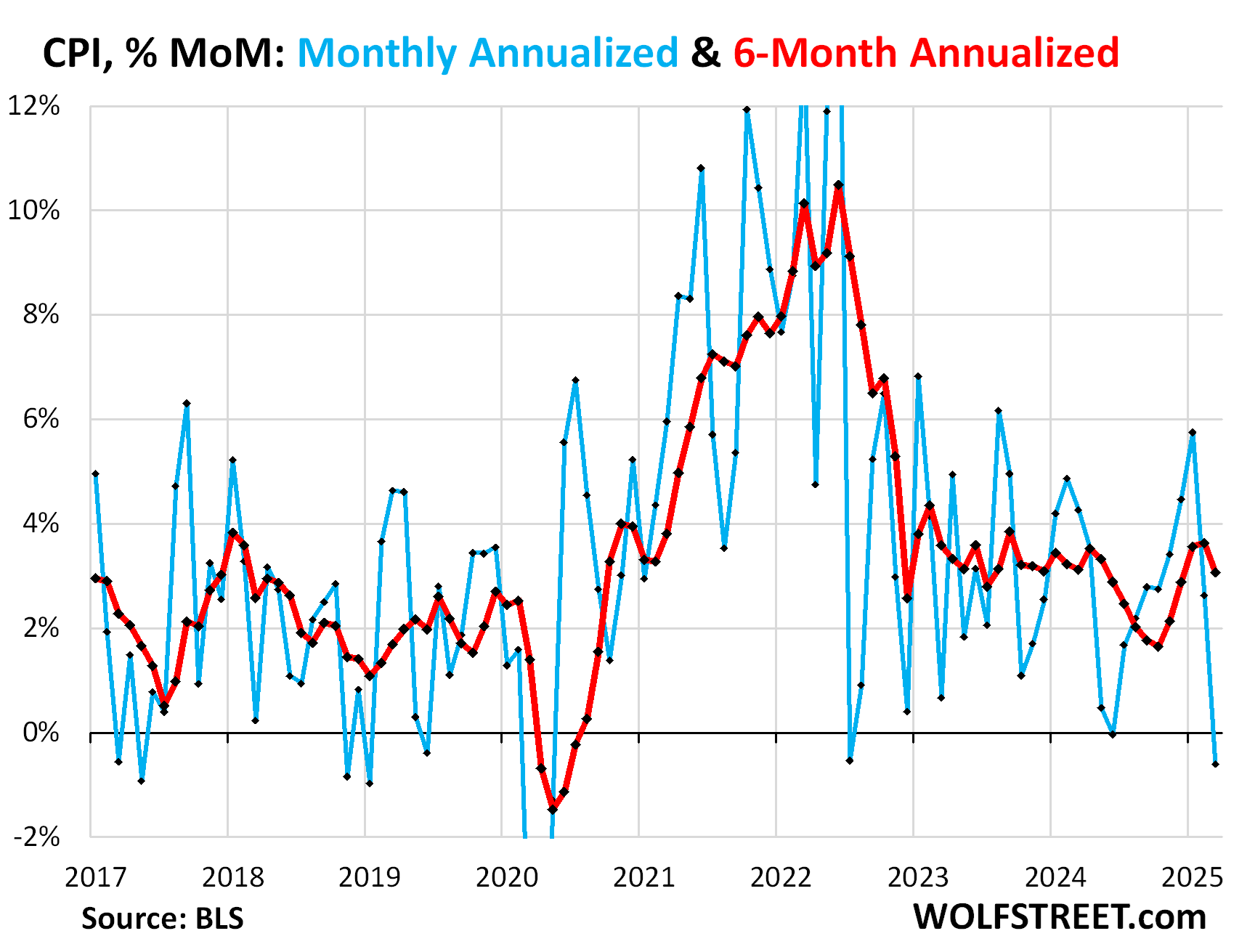
The “Core” CPI, which excludes food and energy components to track underlying inflation, inched up by 0.06% (+0.68% annualized) in March from February, a sharp deceleration (blue in the chart below).
The 6-month “core” CPI rose by 3.0% annualized, the second deceleration in a row (red).
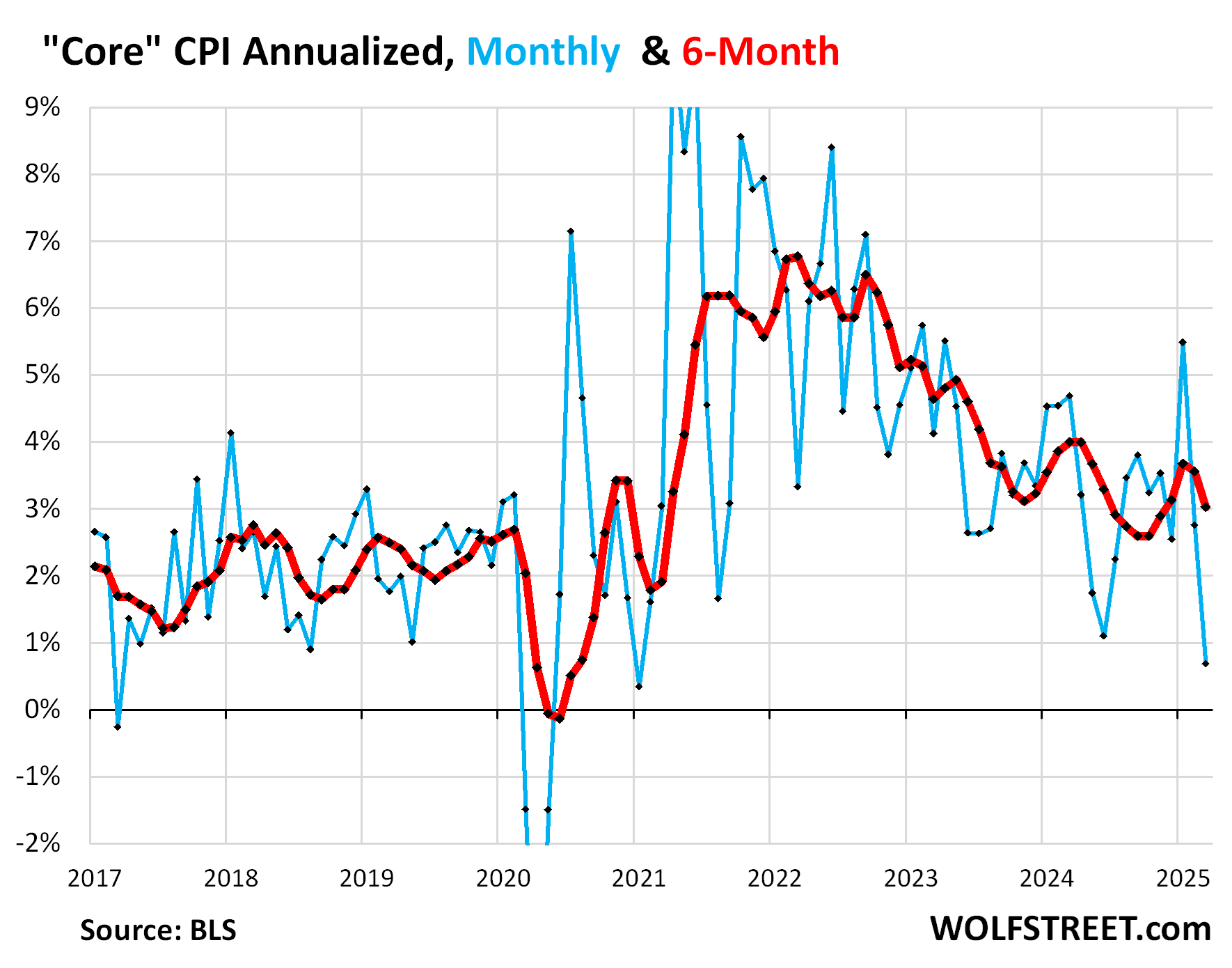
The major components, year-over-year:
- Overall CPI: +2.39% (yellow), deceleration from +2.82% in February.
- Core CPI +2.79% (red), deceleration from +3.12% in February.
- Core Services CPI: +3.68% (blue), a sharp deceleration from +4.12% in February, largely driven by the plunge in travel-related services, and by the drop in motor vehicle insurance, overpowering the acceleration of housing costs and medical care insurance.
- Durable goods CPI: -1.0% (green), the smallest year-over-year decline since June 2023.
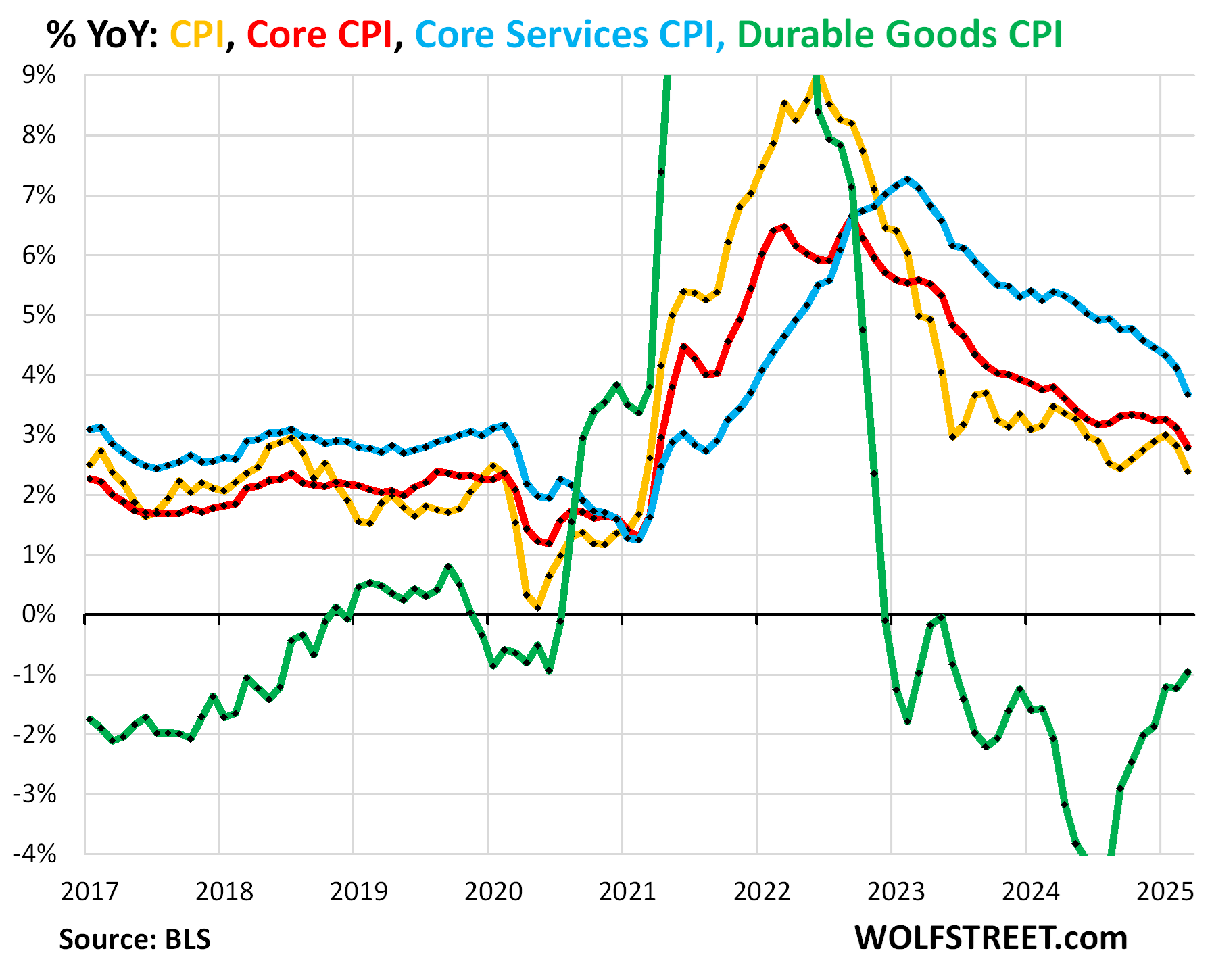
“Core services” CPI.
Core services CPI inched up by 0.11% in March from February (+1.3% annualized, a sharp deceleration from prior months.
Core services include all services except energy services and account for about two-thirds of the overall CPI.
Inflation in the biggies in core services continued to accelerate on a month-to-month basis, including the housing components and medical care services.
But the massive plunge in prices of travel-related services and the drop in auto insurance pushed the core services CPI down.
The 6-month core services CPI rose by 3.5% annualized, a sharp deceleration from February (red).
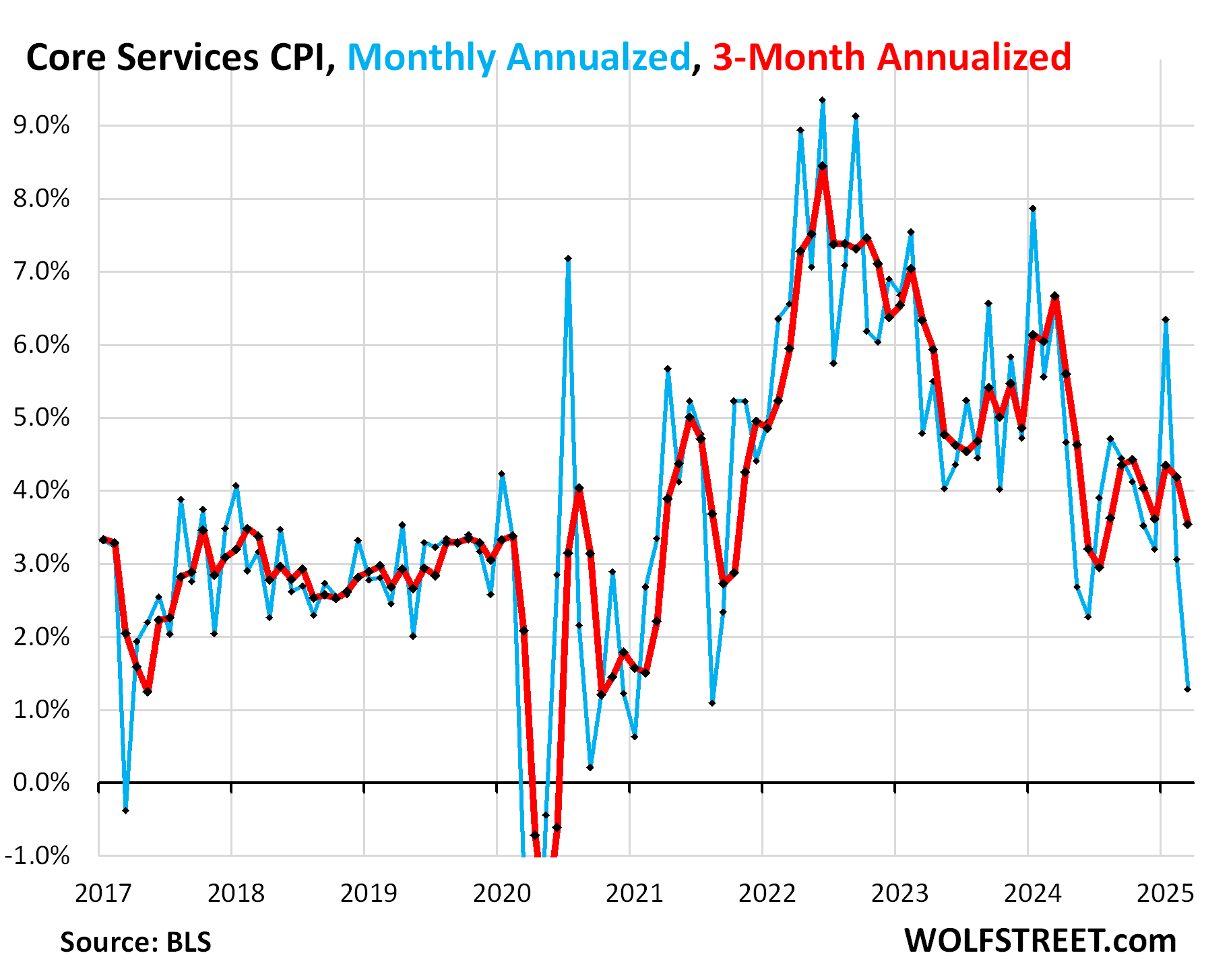
Housing components of core services.
Owners’ Equivalent of Rent CPI jumped by 4.9% annualized (+0.40% not annualized) in March from February, the worst increase since October.
The three-month average, which shows the recent trend, accelerated to +4.1% annualized, the worst increase since November.
OER indirectly reflects the expenses of homeownership: homeowners’ insurance, HOA fees, property taxes, and maintenance. It’s the only measure for those expenses in the CPI. It is based on what a large group of homeowners estimates their home would rent for, with the assumption that a homeowner would want to recoup their cost increases by raising the rent.
As a stand-in for homeowners’ insurance, HOA fees, property taxes, and maintenance costs, OER accounts for 26.1% of overall CPI and estimates inflation of shelter as a service for homeowners.
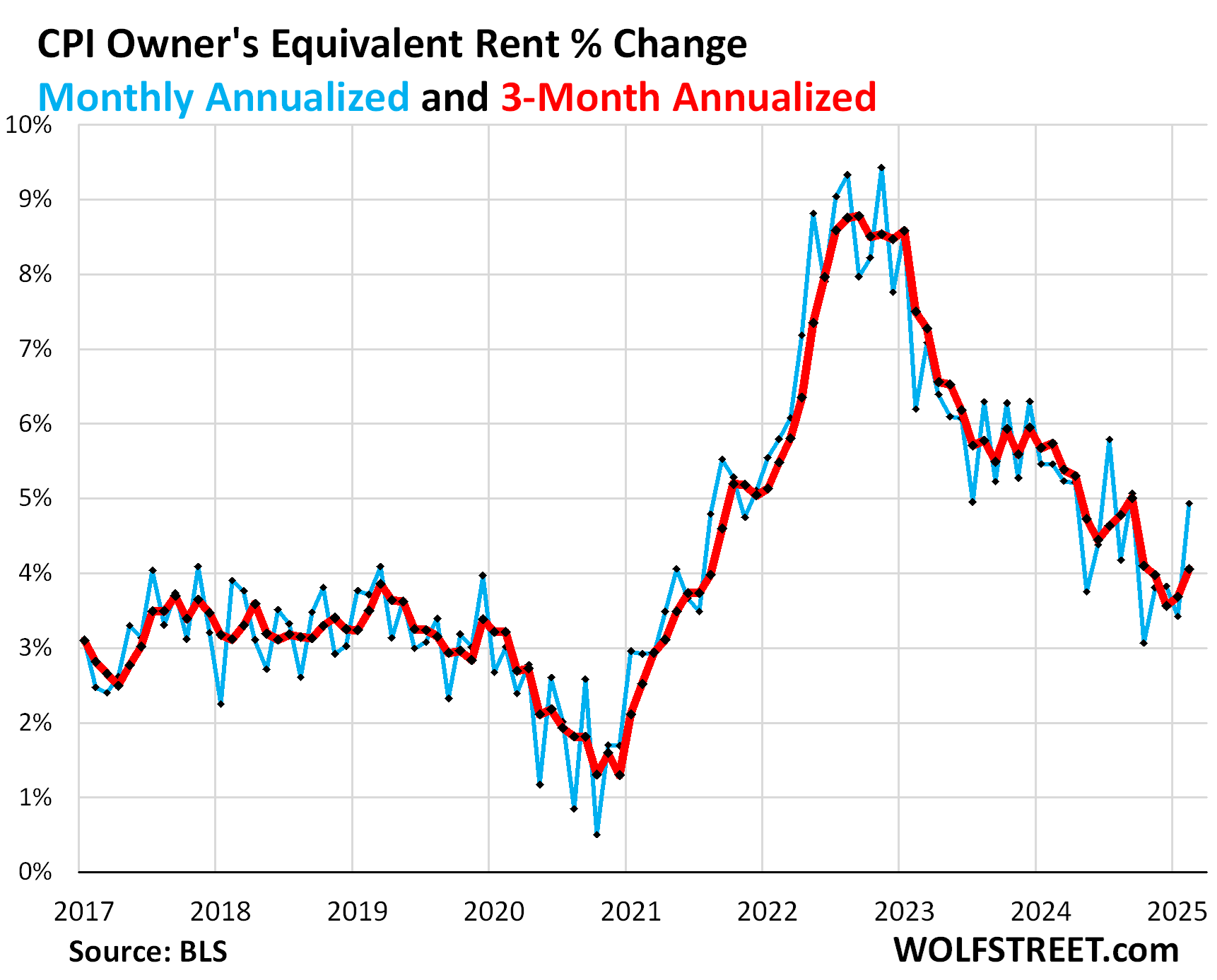
Rent of Primary Residence CPI accelerated to +4.1% annualized in March from February.
The 3-month rate accelerated to +3.9% annualized, the worst increase since September, and the fifth month in a row of acceleration.
Rent CPI accounts for 7.5% of overall CPI. It is based on rents that tenants actually paid, not on asking rents of advertised vacant units for rent. The survey follows the same large group of rental houses and apartments over time and tracks the rents that the current tenants, who come and go, pay in rent for these units.
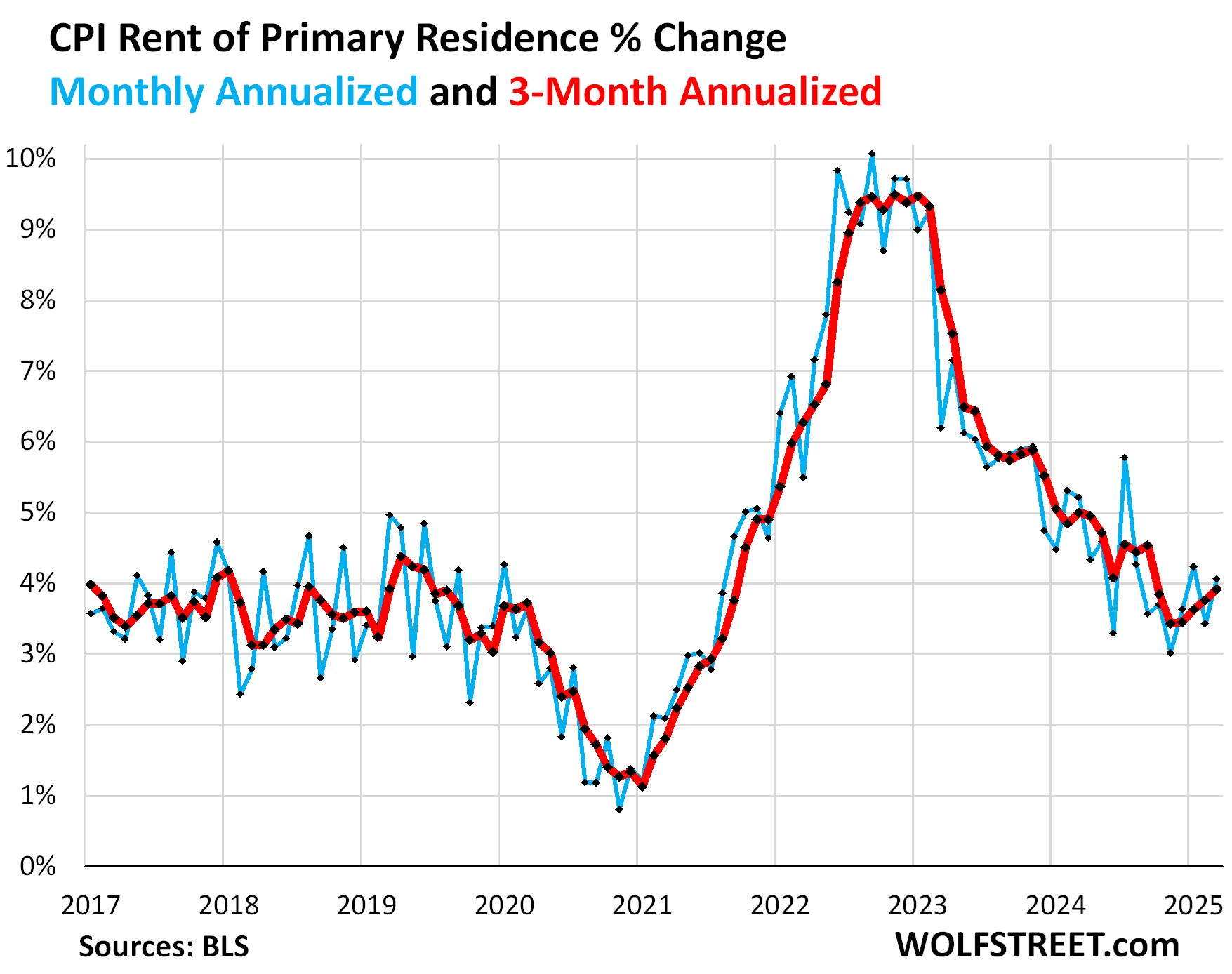
Year-over-year, rent CPI (blue in the chart below) rose by 4.0%, a slight deceleration from the prior month (+4.1%). And OER rose by 4.4%, roughly the same as in the prior month (red).
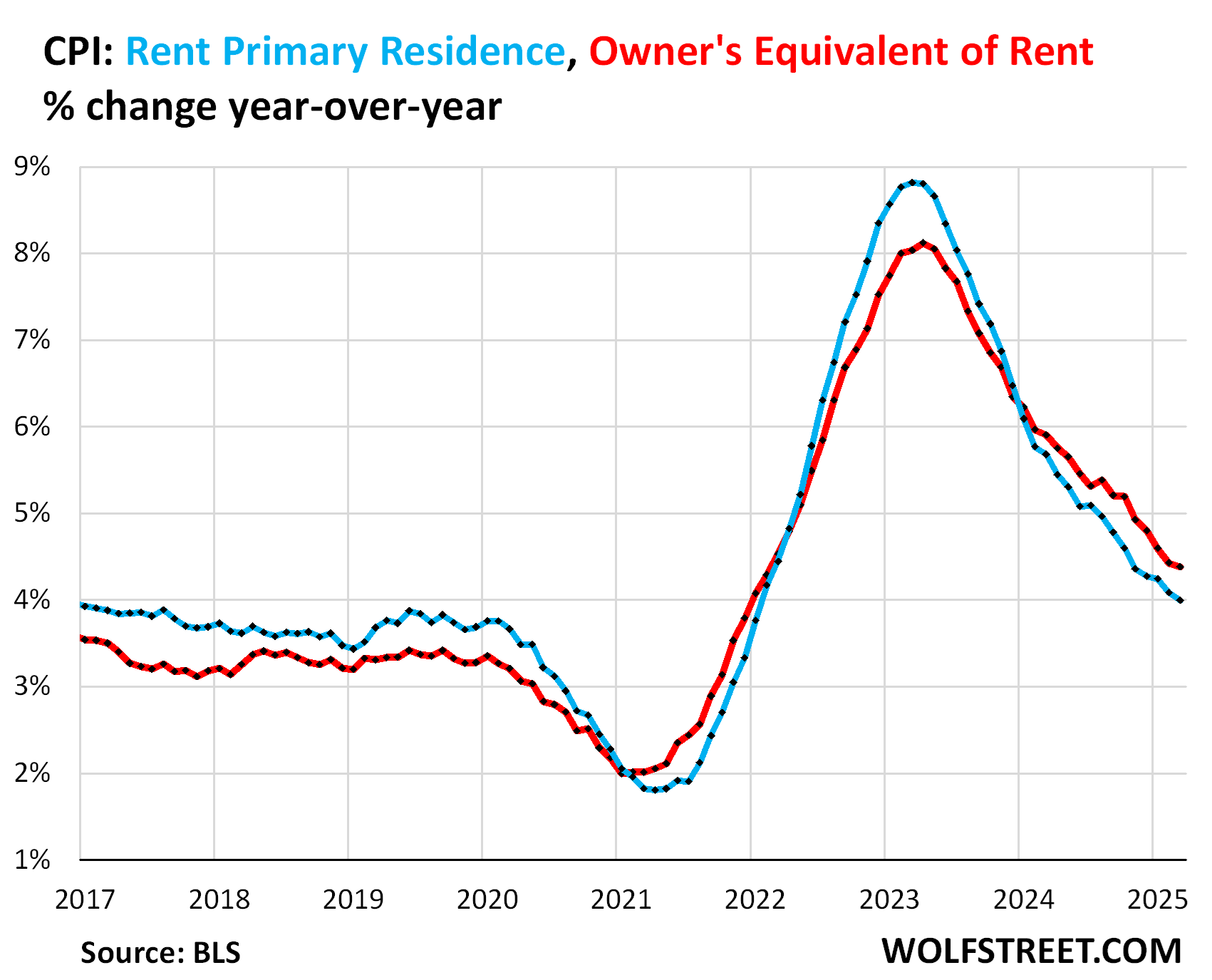
Rent inflation vs. home-price inflation: The red line in the chart below represents the CPI for Rent of Primary Residence as index value. The purple line represents Zillow’s “raw” Home Value Index for the US through February. Both indexes are set to 100 for January 2000. But home-price changes vary by metro and range from steep declines to continued increases, see the 33 Most Splendid Housing Bubbles in America.
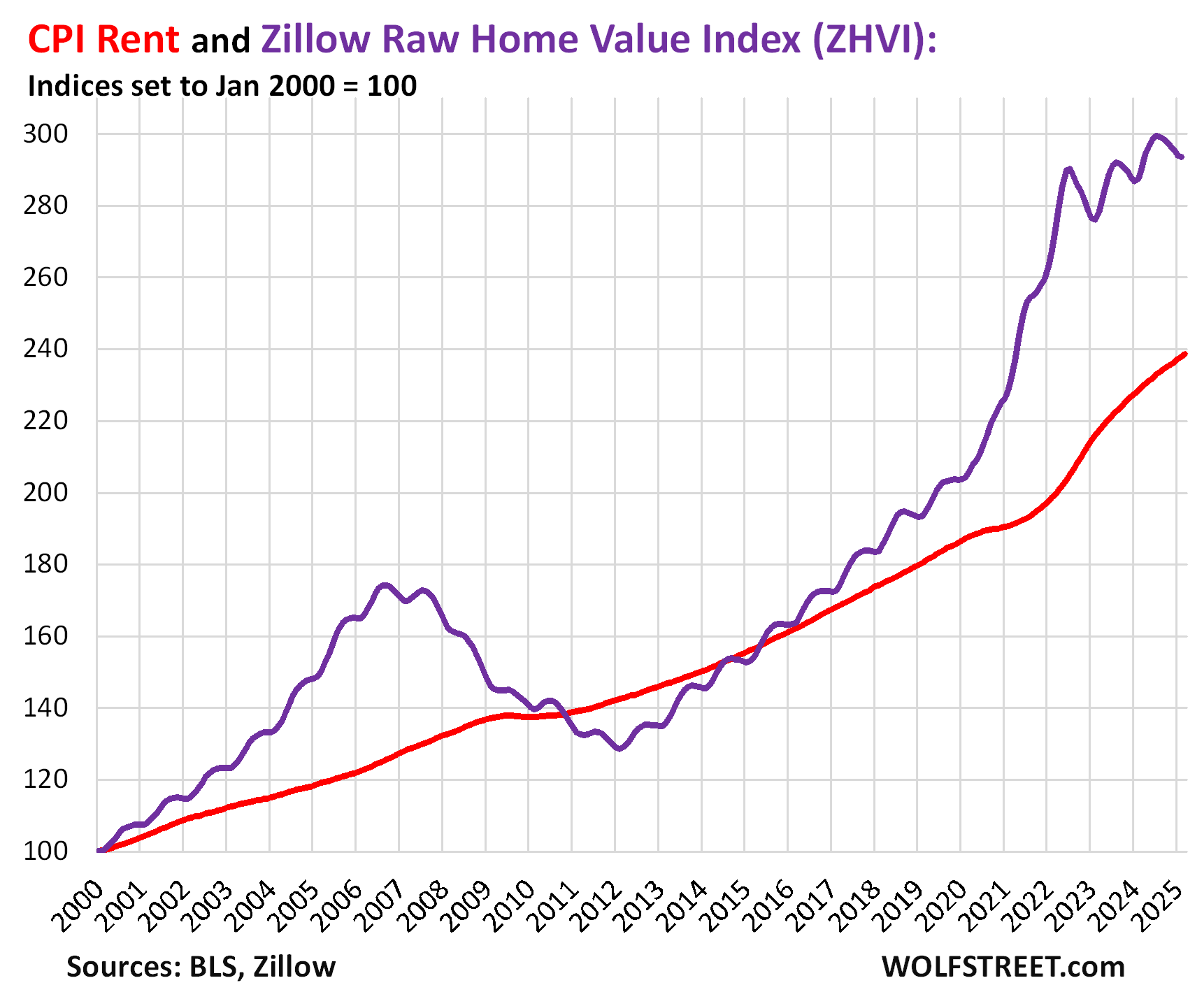
The CPI for motor-vehicle maintenance & repair jumped by 10.6% annualized in March from February, the worst month-to-month increase since October. Year-over-year, the index rose by 4.8%.
Since January 2020, the index has surged by 41%. This chart shows the price level, not the year-over-year percentage change:
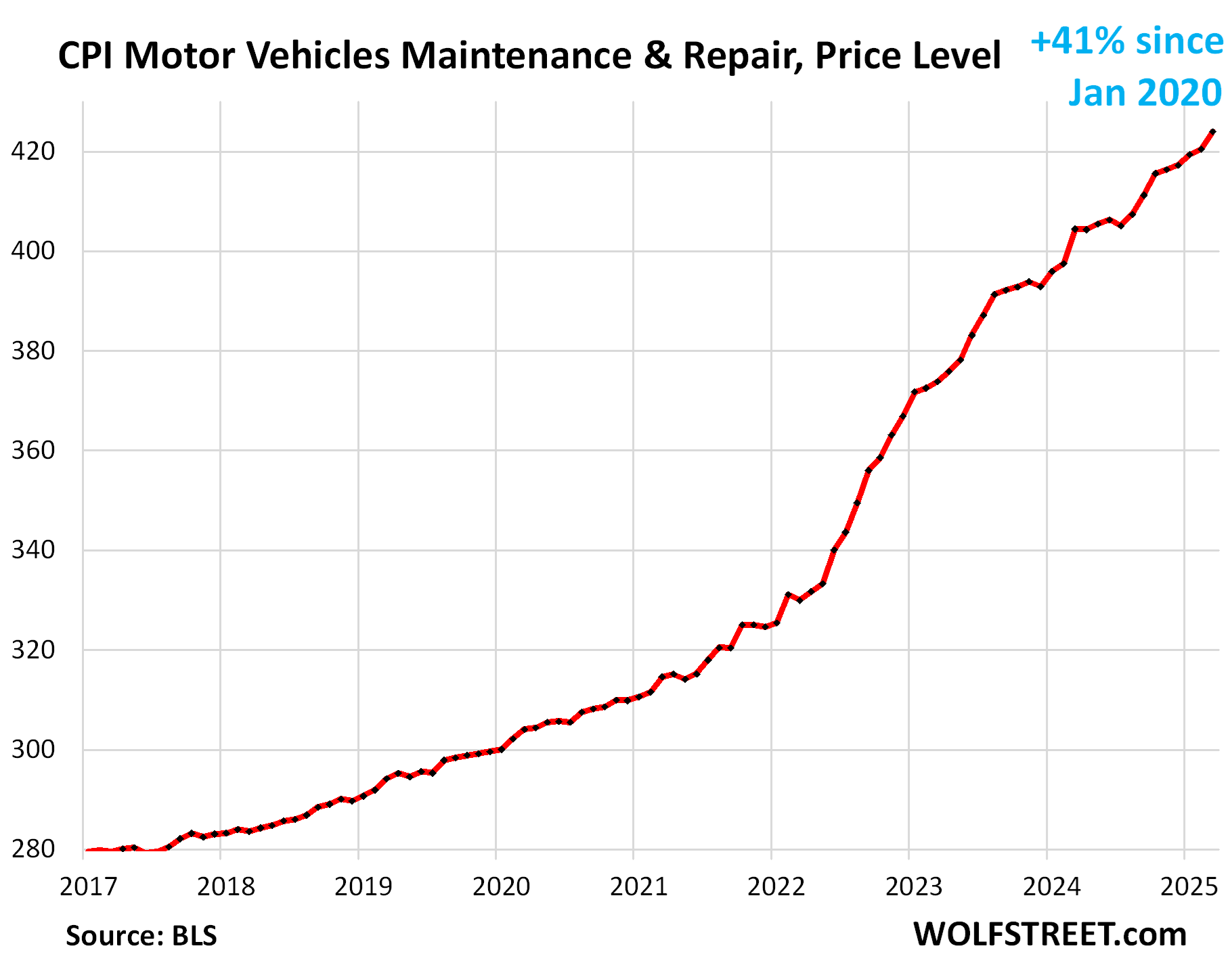
The CPI for motor vehicle insurance fell by 8.7% annualized in March from February. This drop cooled the year-over-year increase to +7.5%, the smallest increase since July 2022.
Since January 2022, motor vehicle insurance prices have exploded by 55%, fueled by the surge repair costs and the historic spike in used vehicle prices (replacement costs for insurers) in 2021 and 2022.

Food away from Home CPI rose by 4.5% annualized in March from February. Year over year, the index accelerated to +3.8%, worst increase since October.
These food services include full-service and limited-service meals and snacks served away from home in restaurants, cafeterias, at stalls, etc.
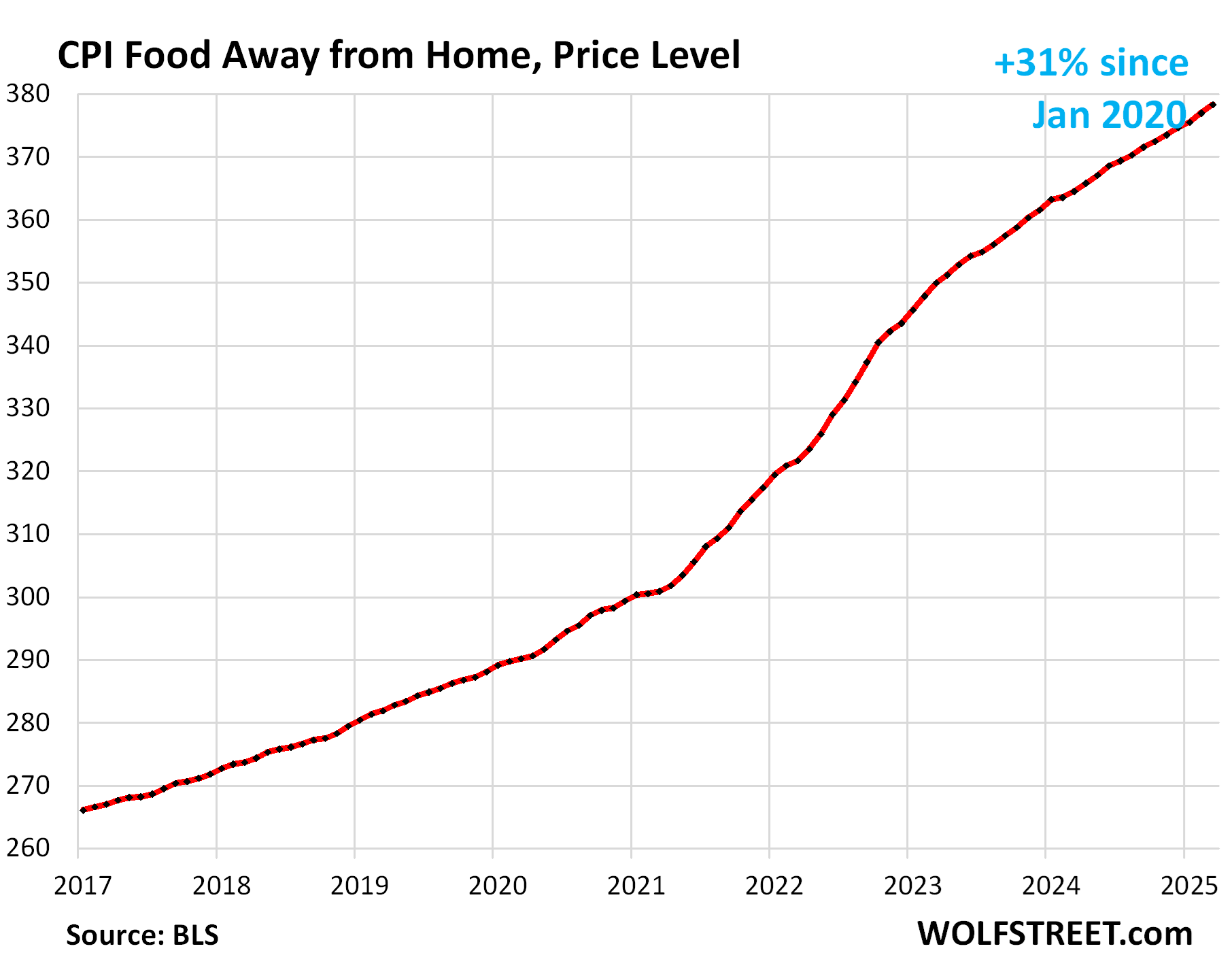
The table below shows the major categories of “core services.” Combined, they accounted for 64% of total CPI:
| Major Services ex. Energy Services | Weight in CPI | MoM | YoY |
| Core Services | 64% | 0.3% | 4.8% |
| Owner’s equivalent of rent | 26.2% | 0.4% | 4.4% |
| Rent of primary residence | 7.5% | 0.3% | 4.0% |
| Medical care services & insurance | 6.7% | 0.5% | 3.0% |
| Food services (food away from home) | 5.6% | 0.4% | 3.8% |
| Motor vehicle insurance | 2.8% | -0.8% | 7.5% |
| Education (tuition, childcare, school fees) | 2.5% | 0.4% | 3.7% |
| Admission, movies, concerts, sports events, club memberships | 2.1% | 0.5% | 5.6% |
| Other personal services (dry-cleaning, haircuts, legal services…) | 1.6% | 1.6% | 4.7% |
| Public transportation (airline fares, etc.) | 1.5% | -4.2% | -3.5% |
| Telephone & wireless services | 1.5% | -0.1% | 0.1% |
| Lodging away from home, incl Hotels, motels | 1.3% | -3.5% | -2.5% |
| Water, sewer, trash collection services | 1.1% | 0.2% | 4.9% |
| Motor vehicle maintenance & repair | 1.0% | 0.8% | 4.8% |
| Internet services | 0.9% | 0.3% | -1.1% |
| Video and audio services, cable, streaming | 0.8% | -0.7% | 2.0% |
| Pet services, including veterinary | 0.5% | -0.2% | 4.7% |
| Tenants’ & Household insurance | 0.4% | -0.3% | 2.2% |
| Car and truck rental | 0.1% | -2.7% | -8.7% |
| Postage & delivery services | 0.1% | 0.4% | 2.9% |
Prices of Goods.
The used vehicle CPI: March was the beginning of tax refund season when used-vehicle prices normally jump. But this March they rose only slightly from February: +0.21% (+3.8% annualized), not seasonally adjusted.
So seasonally adjusted, the index fell by 0.69% (-7.9% annualized) month-to-month.
Year-over-year, used vehicle prices rose by 0.6%, the third month in a row of year-over-year increases. The historic plunge of used vehicle prices from early 2022 through August 2024 was one of the factors in the cooling of CPI inflation over that period.
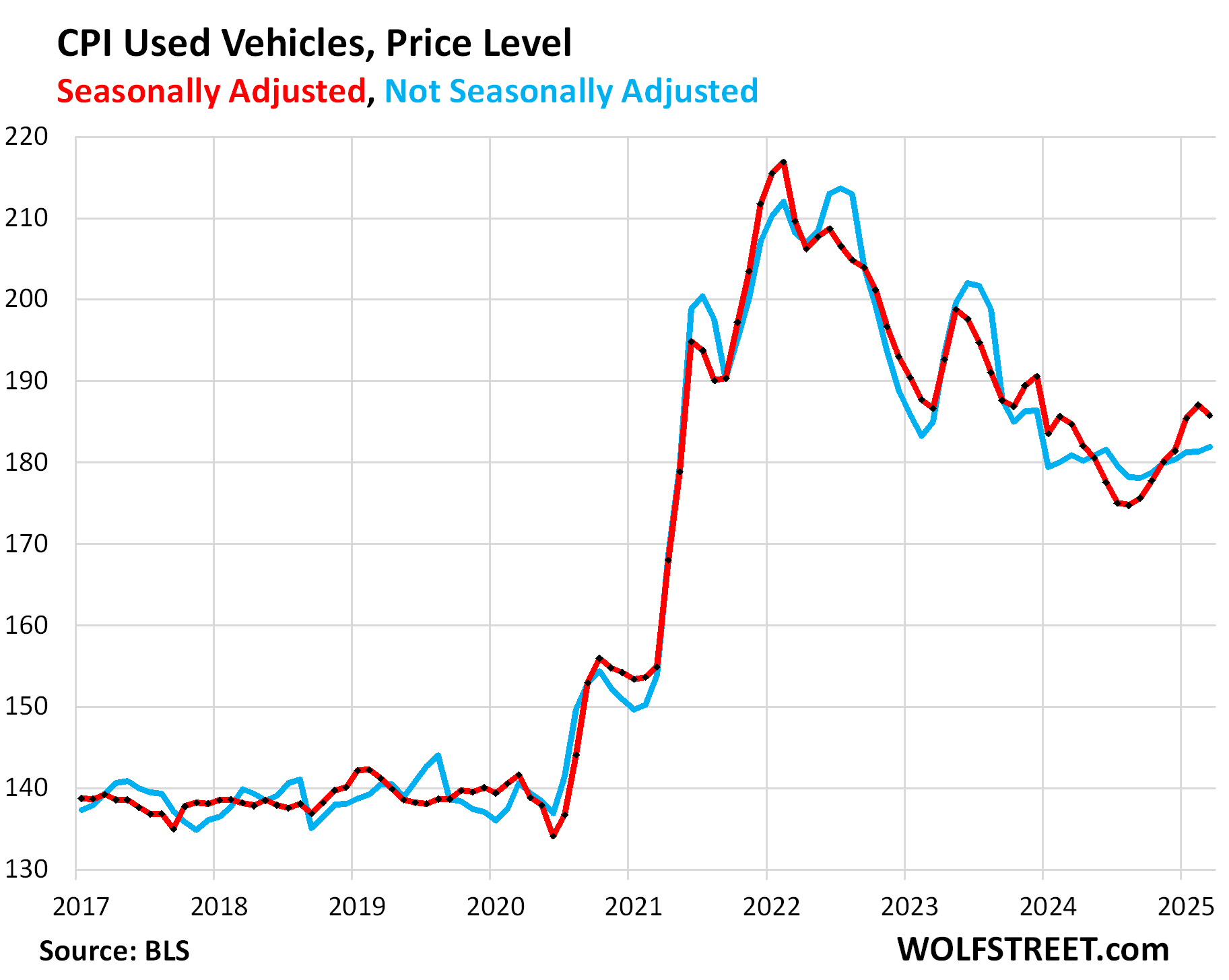
New vehicles CPI edged up month-to-month by 0.1% (+1.2% annualized), seasonally adjusted. Year-over-year, the index also edged up by 0.1%.
Since early 2023, new vehicle prices have been sticky, unlike used-vehicle prices. In Q1, new vehicle unit sales increased solidly, powered by a big increase in March, on top of decent growth in January and February, producing the best Q1 since 2019 [read: Our Drunken Sailors Are Back], after already strong sales growth in Q4. This increase in demand over the past six months may have been why prices haven’t eased.
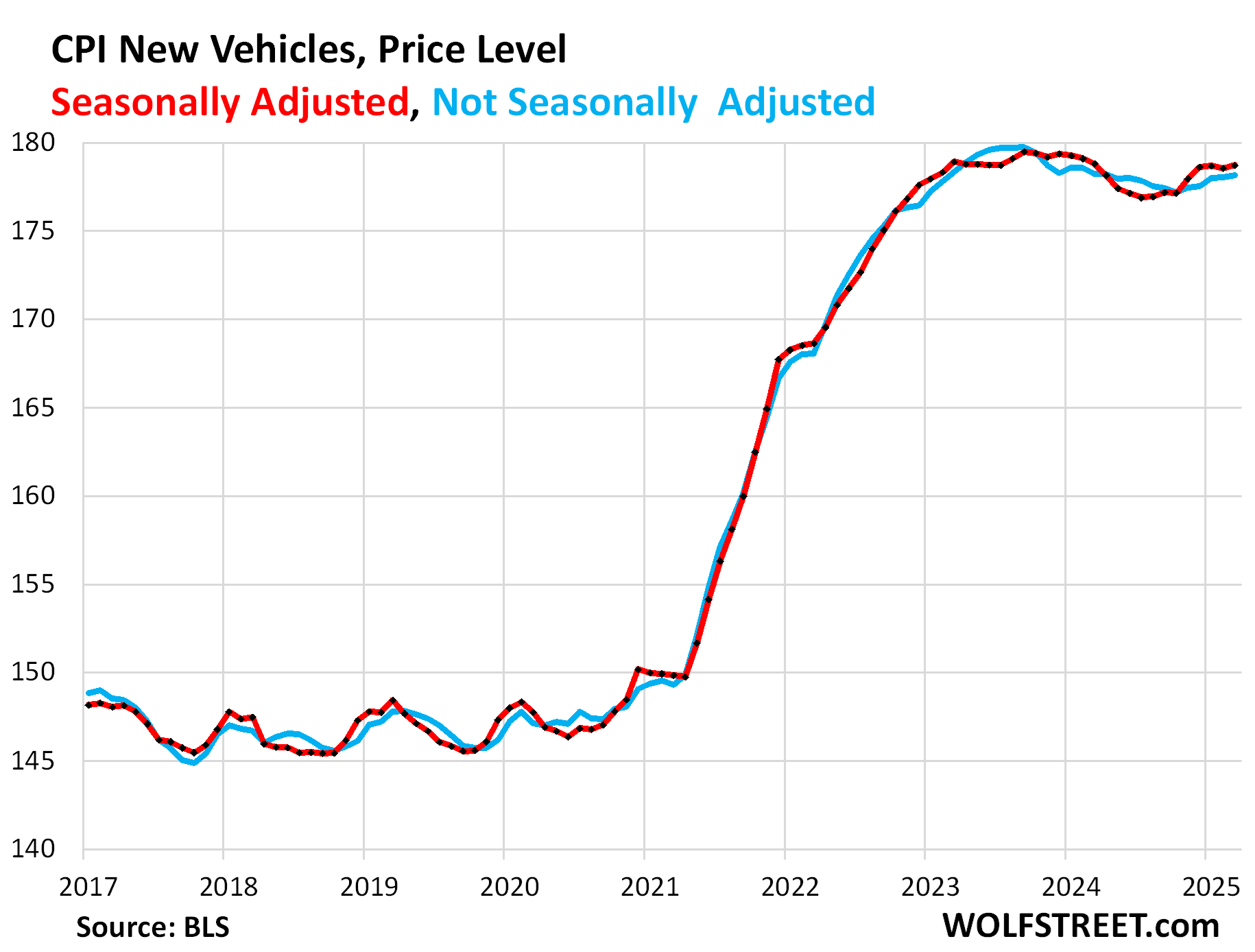
Durable Goods overall – dominated by new and used vehicles – experienced price declines (deflation) across the board from mid-2022 through August 2024, after the huge price spikes during the pandemic. But starting in September 2024, prices of durable goods have started to edge higher unevenly:
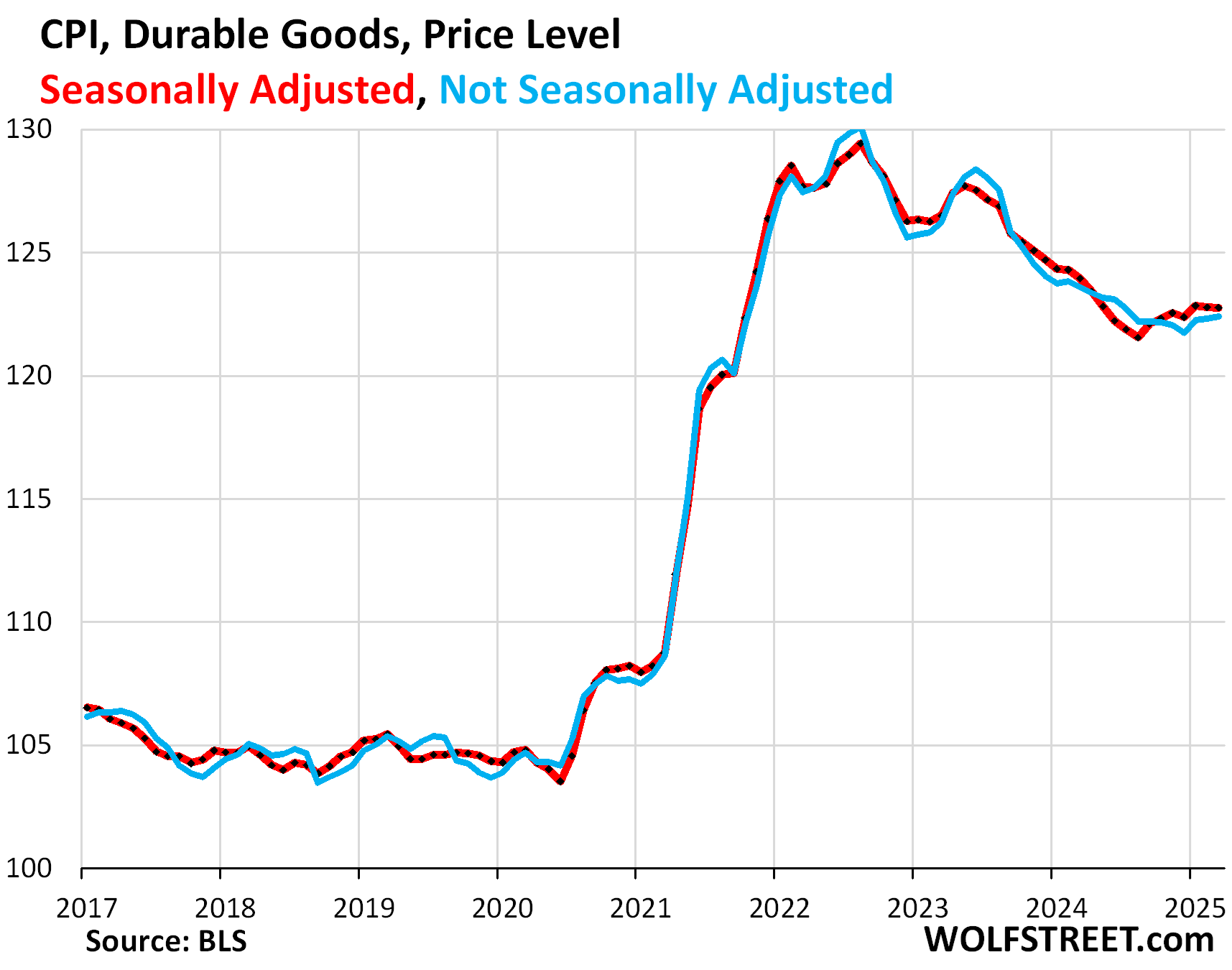
| Major durable goods categories | MoM | YoY |
| Durable goods overall | 0.0% | -1.0% |
| New vehicles | 0.1% | 0.0% |
| Used vehicles | -0.7% | 0.6% |
| Household furnishings (furniture, appliances, floor coverings, tools) | 0.0% | -0.3% |
| Sporting goods (bicycles, equipment, etc.) | -0.6% | -5.0% |
| Information technology (computers, smartphones, etc.) | 0.4% | -7.4% |
Food Inflation.
The CPI for “Food at home” jumped by 0.5% month-to-month (+6.0% annualized), the worst increase since October 2022, with big increases in many categories, particularly eggs (due to the avian flu), beef, pork, poultry, dairy, juices, and baby food.
Year-over-year, the index rose by 2.4%, the worst increase since August 2023. Since January 2020, food prices have surged by 28%. This is food purchased at stores and markets to be eaten off premises.
| MoM | YoY | |
| Food at home | 0.5% | 2.4% |
| Cereals, breads, bakery products | -0.1% | 1.1% |
| Beef and veal | 1.2% | 8.6% |
| Pork | 1.7% | 2.9% |
| Poultry | 0.9% | 0.9% |
| Fish and seafood | -1.5% | 0.2% |
| Eggs | 5.9% | 60.4% |
| Dairy and related products | 1.0% | 2.2% |
| Fresh fruits | -0.4% | 1.2% |
| Fresh vegetables | -1.0% | -3.0% |
| Juices and nonalcoholic drinks | 0.7% | 1.6% |
| Coffee, tea, etc. | 0.4% | 4.5% |
| Fats and oils | 0.5% | 1.1% |
| Baby food & formula | 0.6% | 0.0% |
| Alcoholic beverages at home | 0.3% | 0.9% |
Note the jump in March, worst month-to-month increase since 2022:
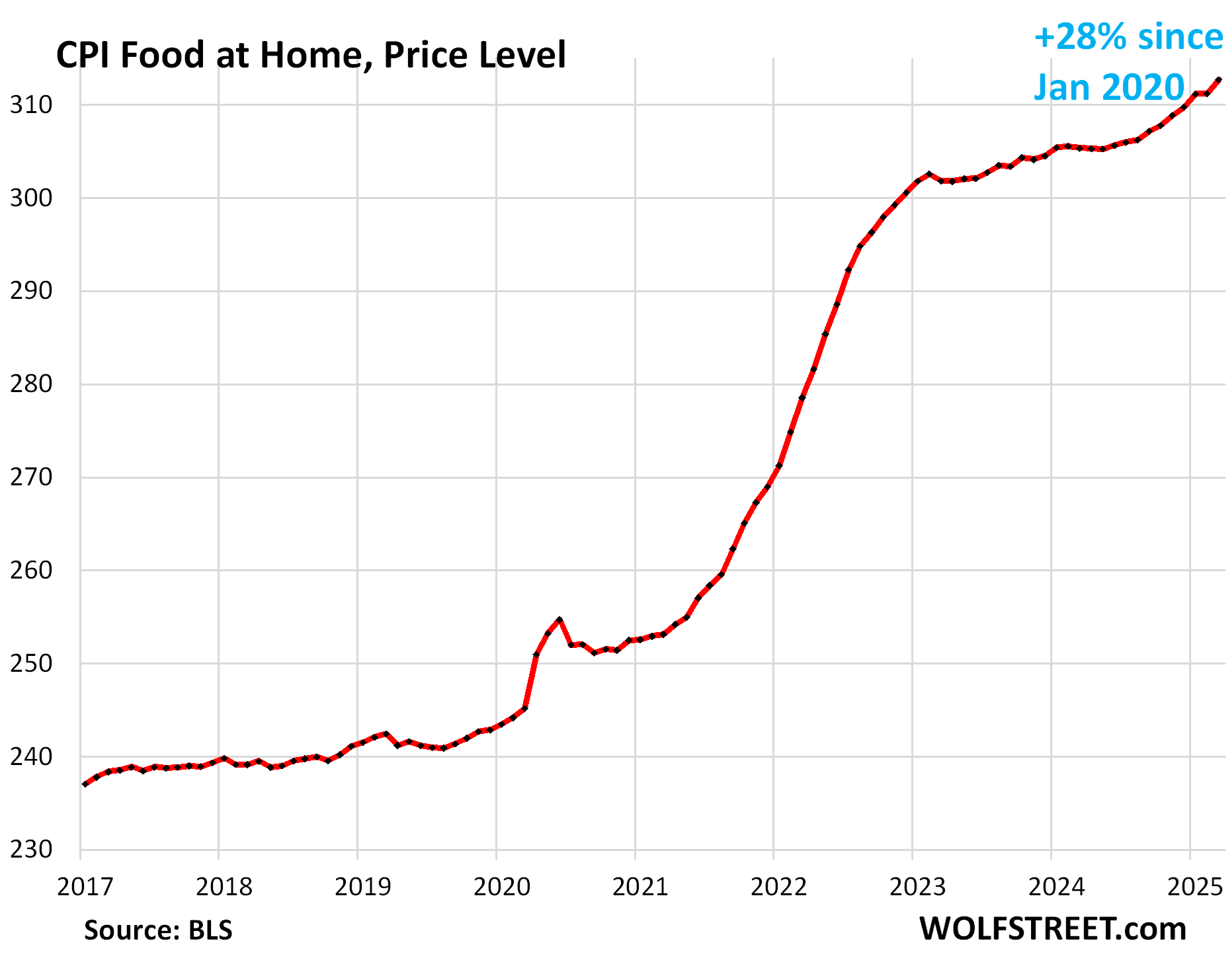
Apparel and footwear.
The CPI for apparel and footwear rose by 0.4% (not annualized), and year-over-year by 0.3%.
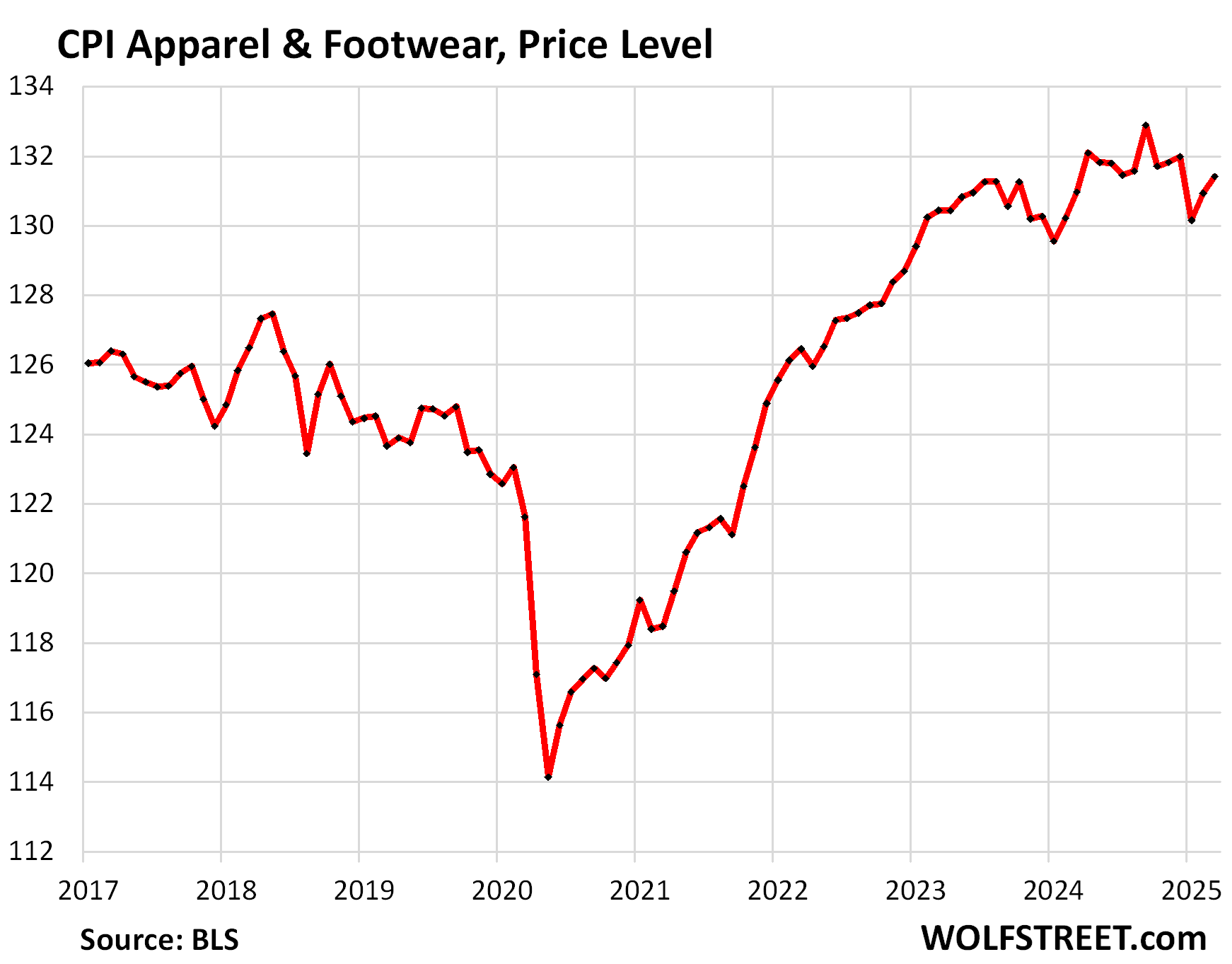
Energy.
The CPI for gasoline, not seasonally adjusted, fell in March from February, which was unusual because gasoline prices generally rise in March. So the seasonally adjusted index plunged by 6.3% (not annualized).
Year-over-year, the gasoline index plunged by 9.8%, to the lowest price level since September 2021. The driver here is the continued plunge in oil prices. Gasoline makes up about half of the overall energy CPI.
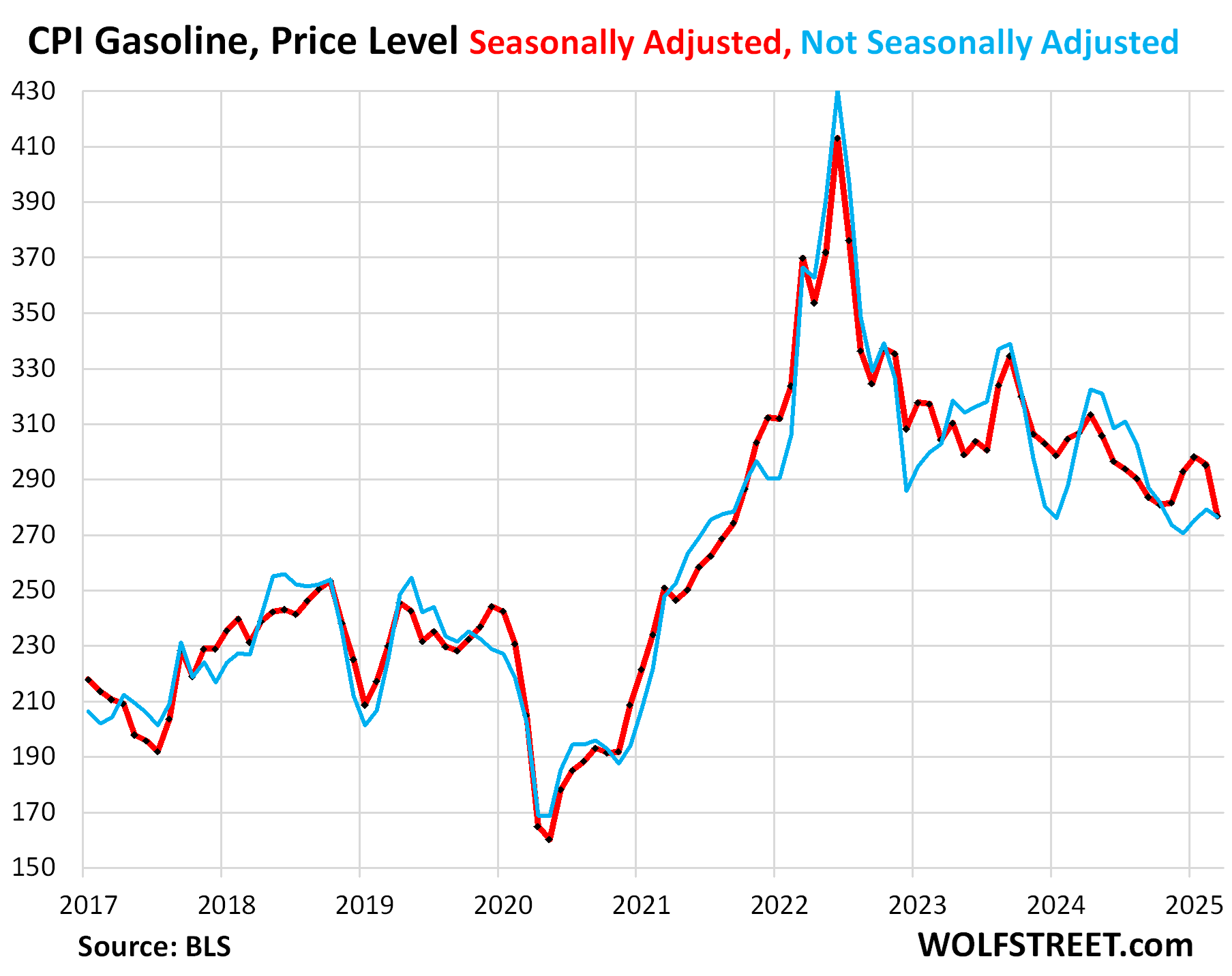
The CPI for energy plunged month-to-month by 2.4% (not annualized), driven by the plunge in gasoline prices. But prices for electricity and natural gas piped to the home jumped.
| CPI for Energy, by Category | MoM | YoY |
| Overall Energy CPI | -2.4% | -3.3% |
| Gasoline | -6.3% | -9.8% |
| Electricity service | 0.9% | 2.8% |
| Utility natural gas to home | 3.6% | 9.4% |
| Heating oil, propane, kerosene, firewood | -3.0% | -3.3% |
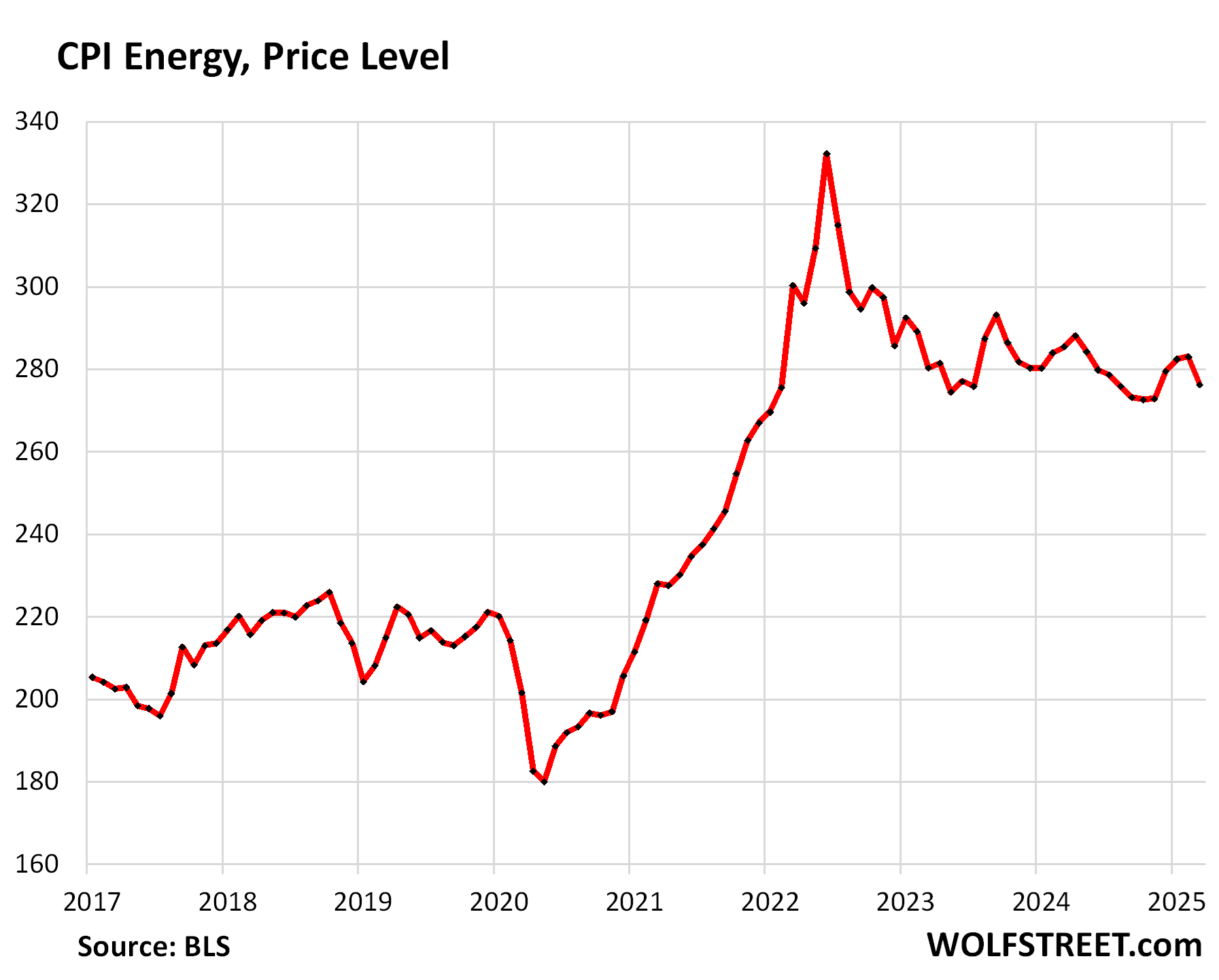
Enjoy reading WOLF STREET and want to support it? You can donate. I appreciate it immensely. Click on the mug to find out how:
![]()

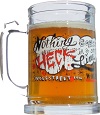
“CUT INTEREST RATES, JEROME, AND STOP PLAYING POLITICS!” – said the POTUS…tick tock Pow Pow, this data unfortunately won’t give you any cover to do it but will it ultimately be your choice? Time will tell….
The Fed is telegraphing stagflation,
and for his irritation,
POTUS went to SCOTUS
to test the powers of emanation
and the bond market, sensing conflagration
looked for clues
in reruns of The White Lotus
The first estimate of the inflation measurement, with a standard deviation equal too the mean which is presumably equal to the reported values. Which additionally has a recent history of the sequence of subsequent revisions was an increase.
So, monetary policy may be targeting three pct inflation rather than they’re stated goal to us dweebs of two percent.
Unless it is an accurate representation of the plan for siphoning the middle class wealth than an inflationary program.
Kind of a mixed bag. At least core was a good print.
I think food will be better next month as retail egg prices come down.
Overall good and hopefully it can get better
lol, egg prices surged today and Easter is coming up.
Lol wholesale is way down off peak but okay. You are reading March prices.
Here you go if you want to read
https://tradingeconomics.com/commodity/eggs-us
Store prices are all that matter to consumers, and they are still nosebleed.
Wolf’s charts clearly show a slow reversion to mean from the peak a couple of years ago. The bird flu was the primary driver of egg prices. Producers had to cull millions of birds, and it is subsiding now. Hens can start producing at a young age, so egg prices should return to normal over the next few months as supply returns to normal. All in all, you’re right, a decent report. Rent and housing prices are still the killer. I’m not sure politicians want to take that one on though.
What percentage of food Costs are actually tied up in eggs?
I suppose they’re in a lot, but meat, veggies and 100s of other dry goods are probably more substantial?
Sugar, grains and other “base” ingredients are hovering at a higher level than 5 years ago.
Wall Street has been furiously dumping / panic-selling most commodities except gold in anticipation of a tariff-driven recession. Oil, copper, lumber etc. are considerably cheaper than they were 2 weeks ago. It’s actually possible inflation numbers will continue to improve.
Apparently we all misunderstood what was meant by “Golden Age.”
Oh no no, the great communicator never said Golden Age, he said Golden Egg.
They (the wealthy) do give the peasants clues as to what they will do. Apparently “liberation day” was also misunderstood, as it is now clear that it meant the rest of the world would be “liberated” from doing business with the U.S. or maybe “liberated” from dollar hegemony…
Interesting times.
IMO, the world is slipping into a recession, anyway. From my point of view, there is an asset price balloon that is being inflated by a continuous flow of gas which to me translates to a complementary financial variable, liquidity.
The real bubble, the mother bubble, is the debt bubble, currently being subsidized by the government’s doctrine which encapsulated and codified the worst American decisions. A gallery of questionable political decisions that belongs too us all.
The competitor of the American worker became the low cost producer, the Chinese Communist Party
Offering an unlimited sea of willing peasants yearning for meager, subsistence.
And since this broad multi decadal plethora of Chinese manufacturing jobs wind up fueling their economy long term, that country eventually reveals itself to be more prosperous, causing wages to rise, then the U.S. no longer enjays the ultra cheap prices AND we are still dependent on them.
https://wolfstreet.com/2018/09/23/what-i-told-the-white-house-about-trade/
and I’d welcome you to look at corporate income trends since the ‘pandemic’ as well
Great for construction and maintenance businesses. Unfortunately, the average Joe/Jane continues to see the cost of services and groceries explode and continue to rise, as Wolf has diligently documented. Local municipalities will be looking to increase taxes so it looks like it is time to fight the county on the assessed property values! It canbe done and you can win, or at least lock in an assed value that they cannot change for up three years. THIS is why rents have been going up IMO (and I am a landlord).
There has been no panic whatsoever – barely a dent in prices.
Overall CPI: 239%
Yowza
🤣 thanks
I have a google flight tracker for SFO to London and the prices are down when they normally would be up seasonally. There’s speculation that no one wants to come to the U.S. during these *interesting* times while no one wants to leave in case they can’t get back in.
So basically flights are cheap for US citizens? I fail to see the bad part about that. Flights have been ridiculous for years now. Tourism is an economic trap
Well… Tourism is a big economic driver so no tourism has a domino effect
Tourism yes. It makes up 3 percent. I believe international tourism makes up like 1 percent pre-covid. I can’t find the data.
It doesn’t drive as much as you think.
“It doesn’t drive as much as you think.”
it drives me nuts more than you think.
Just booked a summer vacation, I saw no discounts compared to previous years. Flights the same, hotels the same, campgrounds the same as the past several years. Only deals I’ve gotten were just as the covid lockdowns were lifted. That was a great but weird time for traveling.
Yeah, I’m wondering where these cheaper hotels are. I haven’t found them. Prices are still ludicrous, and higher if anything.
I’m wondering where the cheaper gas is too. I keep seeing the RBOB dropping, but it’s still the highest price at the pump it has been in over a year around here.
Funny thing is I went out of the USA for the first time since before covid this year and originally ticket prices were high but for the return flights I got upgrades to business class for nearly nothing.
International airports were insane, wall to wall people — at least where I was, it didn’t look like a slowdown at all. But maybe certain countries are having a surge while others are quieting down. Albeit this was during springtime so that may have contributed to the surge.
I post these anecdotes because it’s interesting to see how they measure up with the wider trends.
So basically if you drive and have your own home, you’re not too doing badly. But if you’re a renter in the big city, paying much of your limited income on food and an apartment, you’re screwed. Does that about cover it?
Not quite because OER is a stand-in for the costs of homeownership, such as insurance, property taxes, maintenance and repairs, HOA fees, etc. And they’re all shooting higher, and homeowners have to deal with them. Lots of complains about those costs here in the comments. These are big budget items.
Home values have a lot to do with home insurance and just about everything to do with property taxes. My insurance went up another 10% about an hour north of denver. It is getting ridiculous at this point. I don’t know how any administration helps reign in those costs.
move another hour north ;
“HOA feeds,” Yep, those HOA pigs will slurp up everything they can.
In my area, we have a HOA but it’s one of those powerless ones that doesn’t really do much. However, all those other costs you mentioned went up wildly in the last few years. Yes, I’m not happy about it.
Speaking of insurance and HOAs the insurance at our cabin went up just over 50% in the past year (from just over $10K/year to just over $15K) and the HOA fees for condos near us has gone from ~$1k/month to over $2K/month in the past five years or so. A friend that owns a condo told me that the increased cost is related to higher insurance for his HOA but also radically higher labor costs since they need to pay people to drive in fron Reno for every small project since few handymen and painters can afford to live in the Tahoe basin anymore.
I am absolutely tickled to death when I hear people complaining about massively spiking real estate taxes, insurance and HOA fees. Smug that sh!t, beaches.
Lol yeah. Rent is a sticky one still because of commodity prices and local supply restrictions in a lot of markets.
I wonder how the vehicle maintenance is calculated. Is comparing the same kind of cars? Cars are just more expensive to maintain now and labor is still missing.
Vehicle maintenance is negligible if you have an EV.
The tires wore out on my Bolt in 17,000 miles (old man driving style, too!). It’s a heavy car, even though its not huge. Well over a grand for 4 tires since it calls for long range tread type. But you don’t get “long range” life……
There are three liquid cooling systems on the electronics and battery and associated pumps and a big fan. The car has the same suspension (ball joints, tie rods, steering gear, axles, shocks and struts, CV joints, etc) as an ICE car. There are filters, and the gearbox has (get ready for this…) 90 weight gear oil in it.
While I don’t do $60 oil changes, I pay a lot for tires sooner. Brakes last longer if you drive “one pedal”, but a lot of people don’t. I love the car though!
There may be less periodic maintenance, but over time, there will be similar repairs to be done.
Vehicle maintenance is zero if you negotiate it with your new ICE car purchase.
Apples to apples like that and I’d still never make up the price difference between my gas car and a EV.
David,
There is no price difference between equivalent ICE and EVs. A Tesla Model 3 doesn’t Compete with a Toyota Corolla — and people who make that comparison are idiots — but with rear-wheel drive sports sedans, specifically the BMW 3 series. So speck out a BMW that performs like a Model 3 (acceleration, etc.), and that’s your comparison, and you will see that the Model 3 costs less.
It looks like rents will be increasing to meet home prices whether incomes go up or not.
Oh and real household incomes have been flat since 2019
https://fred.stlouisfed.org/series/MEHOINUSA672N/
1. “Flat” means “kept up with inflation” and there was a lot of inflation because “real” means “adjusted for inflation.”
2. the annual chart you linked stops at 2023. But 2024 was a big winner for real household income because inflation was a lot lower but wages increased at a good clip.
My insurance policies in California have doubled in 2 years.
My Wisconsin policies are up over 30%.
My Florida policies are up 10%.
I’ve raised rents 30% in 2 years and another 6% on renewing leases this year.
No insurance policies have ‘doubled’ in CA in 2 years and that is prohibited under the State of California insurance laws.
You want a copy of the bill? It was $1532 in 2023 and $2952 this year.
Howdy Folks Will lower oil prices be able to continue the downward trend on Inflation????? Will Beautiful Clean Coal bring down electricity costs????
Have to wait and see.
I am actually waiting for oil stocks to go down (another story). But on the other hand, the crude oil prices along with travel, lodging and rental cars are going down, does that mean the market knows or expects something more? For example, Tourism is down and hence Delta airlines reduced the forecasts. Not trying to confuse you. Clueless as anyone else…
Bubba, if I was King, gasoline would be $0.25/gallon again. With 40 years in the oilfield, I dream a lot and my bones are worn out.
Coal is out of favor, for now (think natural gas), but it’s safe in the ground for a later time. Oh, there is no such thing as “clean coal”,
Howdy Anthony Coal is out of favor? Better tell China that one. Gasoline was near a buck some years ago in the Mid West. You might want to wake up and quit dreaming all the time to see what is really going on.
HEE HEE
China has big coal fields, and can meet its own needs with coal. It doesn’t frack oil fields much so it has to import a lot of nat gas. So coal makes since for China as much as nat gas does for the US. Gasoline prices collapsed during the work from home phase of COVID. Unfortunately, that put a lot of oil fracking companies out of business. So when the country opened back up the oil companies couldn’t produce enough and gas prices went through the roof. I paid over $5 a gallon on a trip though Connecticut. But prices are getting back to pre-COVID norms thankfully.
Well, the most thermodynamically efficient coal process is the blast furnace reactions that occur during the reduction of iron oxides to a molten pool of high carbon pig iron.
Methane contains a molar concentration of hydrogen four times the carbon content. When hydrogen is oxidized and combines with oxygen and heat of course the product of combustion is water. One fifth of the molar quantity is carbon.
I don’t know if natural gas generates as much carbon dioxide at a rate that produces an equivalent amount of energy
I think you’re in the ballpark, but you need to be a little more expansive…
Families are generally hurting, too.
Medical expenses up, child care and education up, food up, etc.
No big deal, it’s only the essentials, but people can go on a slightly cheaper airplane if they can afford to pack up the whole family and take off!
This was intended as a reply up above, but I guess it’ll just have to stand alone…
Those items are all covered in the article, all the family essentials, including baby food and formula.
Agreed, and I made a special point to look at them before I posted.
While your article did a very nice job of covering a broad range of things, my comment was intended to be more of a general observation about about families specifically.
Sadly those are things that just continue to spike with no end in sight regardless of any administration
Really need parties to come together and figure that stuff out
The “family trip” is heading back in the direction of being a driving trip.
Having enough money is an important determinant of family survival.
I’m pretty sure that there is an ocean of minimum wage Americans would gladly produce a gadget for 20 an hour with benefits.
I don’t think there is an “ocean” of minimum wage Americans to begin with. It’s around 1% according to the Bureau of Labor Statistics. These new manufacturing jobs may have to pay more than we think to attract a decent workforce, and drive upward pressure on wages/inflation.
This is my impression too. Essentials show bad inflation. The things that are not showing inflation all are more subject to discretionary spending, and show where average people are cutting back.
Nicely summarized
Just received insurance and HOA bills for my home in a ski community in New Mexico. HOA is up 3%, insurance was a whopping 25% because of fire danger. That’s after 25% increase last year along with $2000 in fire prevention measures. I can lower deductible to reduce costs. I asked my agent what the outlook is for next year, and she said unclear.
Pandemic work from home brought in lots of buyers driving up housing prices and construction costs. It forced me to insure more than my cost basis. Now that there are higher insurance and interest rates, there are more houses on the market longer because no one wants to drop prices. A reset in prices and lack of demand in construction would help insurance prices stabilize if not drop.
Nature Conservancy just launched a new insurance product that incorporates fire prevention measures. Might be worth suggesting to your insurance regulators.
Google, “The Nature Conservancy and Willis Launch First-of-Its-Kind Wildfire Resilience Insurance.”
^^^This – every homeowner I say this too looks at me like I’m crazy, but homeowners are better off if prices stay flat to down for the foreseeable future because unless they’re selling the value of the house doesn’t matter. It only impacts home owners insurance and property taxes.
Honestly didn’t even think about that lol
Silk sheet problems.You should sell that dog property, immediately.
Obviously, the increase in operating expenses are twisting the family jewels unmercifully.
The pain initiates an immediate protective response.
Just got a city clerk’s ballot to vote on a supplemental fee for road maintenance. They have tapped out existing funds. Not sure if the vote is legal. I don’t live on a city street so there are no potholes or streetlights within half a mile. Their source of revenue is property taxes. Its not just Treasuries, the muni bond market is looking a little shaky. The alternative is to forgo services, and that might mean layoffs, which could also trickle down from the Federal cuts. How many state and local jobs depend on a federal grant? It was always much cheaper to send you kid to public school but now maybe you don’t have much choice.
Vote no. Their propaganda has been successful in your case, obviously,
No is not a radical vote, no matter the pressure to make you feel insignificant and surrender your vote too the master demanding it.
So my advice is only vote yes if they have specific projects and a plan.
My city actually asks about these taxes do but they deliver great results.
Takes aren’t bad. Slush fund taxes are
AGREE, like totally Dude:
Paying taxes, as one of my best, actually THE best ”family” guy who not only gave me great advice, mostly, but also paid me $52.50 per hour, $2.50 cash and the rest in ”good advice” and MAJOR MEALS, etc., told me to ”BEE HAPPY” when paying taxes.
Why? Because he said, and, So Far, I continue many decades later to believe:
”When you are paying taxes, it means YOU ARE SUCCESSFUL.”
I can only hope ALL you ”youngins” not only understand that concept, but embrace it…
Thanks once again to the Wolfster for his work…
It may be worth noting here that all of this article and commentary relates to ordinary people. I did not see a mention of costs associated with yachts, private jets, nor exotic jewelry. Also worth noting is the congress just passed a budget bill that grants extraordinary tax breaks for the wealthy while simultaneously promising 1.5 trillion dollars of cuts of benefits for ordinary people.
That will undoubtedly catch up to the elites. To me in this circumstance and time, it is objectively shocking that they’re doing such cuts. It’s not that I think the rich actually have that much wealth to fix everything alone, but it’s still a ridiculous choice if that’s what they’ve done. Once SHTF it puts them in danger.
Luigi Mangione is a hero to millions of Americans. If that’s not a warning sign for the elites, nothing will be.
How can a sicko cold blooded first degree murderer such as Luigi be a hero to anybody who is sane?
An Emerson College poll found that 41% of voters under 30 found the killing acceptable. Another poll found that 81% of college students had an extremely or somewhat negative view of Brian Thompson. These numbers are from late last year, and I expect current events will accelerate the trend toward radicalizing younger Americans. Visceral disgust with the current system is intense and widespread.
Agree with Phil, one of the sharper people that show up here.
The oligarchs and wannabe oligarchs are obviously going to take it ALL to the mat…..a few warning shots across the bow might help……and make security very expensive and tiresome…..kinda ruin their chosen life for them, maybe, before things really go off.
It will be interesting to see how food plays out in the near term if we stay with high tariffs, especially if get some more retaliation other than China. It seems like other nations look at the voting map and decide, let’s go hit those red states.
I would think it would be counter-inflationary to food, but we import a lot too so who knows. Does anyone remember what happened during previous trade battles?
“what happened during previous trade battles?”
My understanding is that Trump subsidized farmers with public money. If so, so much for classical conservatism, or the vaunted fiscal prudence.
Farmers always get subsidized — even to not grow crops.
Howdy Lone Wolf. Right you are . Since before we were born, they pay farmers not to farm.. Corn in our gas tanks while they tell US the world is starving.
They talk about “saving family farms” but in truth most ALL! of the money goes to big corporations…Cargill, ADM,….etc,etc
My fiancé grew up in a nice little town (Grant) ALL supported by family farms…….it is a “blighted area”, now, per state of Nebraska.
But they do piss away money in the ethanol biz to give some jobs to those who don’t just get cash….beats a poke in the eye with a sharp stick.
Why not vote to have a moron blow up the gov’t? Especially with talk radio host grifters pushing for it?
NBay
A lot of farm land is now owned by hedge funds and PE firms.
Re-Bubba comment,
LAND BANKS were JUST THAT
Saved water, too.
But I totally agree with burning food and also would add stuffing pigs and cows with it idiocy.
Major health problems with that, too….look up CMAH gene, sialic acid, and glycocalyx since you are old like me and have time to REALLY learn.
More than half of farm income comes from the Federal government and it has been this way for decades.
Those subsidies should be cut to zero immediately.
I’d like to welcome you to the 1930s. Try to catch up.
Not sure why my comment got deleted. US farm subsidies began in 1933 with the Agricultural Adjustment Act which was adjusted with the 1938 Ag Adj Act. Government farm subsidies are nothing new.
It was accidentally deleted and has been restored, see above.
Household impacts for food will be diet-dependent. I suspect hits to Asian and other international grocers. I like to shop for some items that I can’t find anywhere else but Asian grocery stores. I unfortunately expect prices to jump for my favorites. Back to a diet of California-grown rice, beans, and local veggies. Eating fewer imported fruits is a bummer.
Might be more complicated than that.
I’m no expert, but here’s one example – pretty much all farming depends on fertilizer, one of the major ingredients of which is called potash.
Most of the potash comes from Canada. Trump knocked the tariff down from 25% down to 10%, but who knows what will happen to future…
“The U.S imports 90 per cent of the potash its farmers need annually and 85 per cent of it comes from Canada. Almost half of the product out of Saskatchewan in 2023 went to the U.S. market.”
The cost of potash in a loaf of bread is microscopic.
I figured as much, but it still strikes me as pretty mission critical if trade wars heat up.
Of course, the US is a top source for the hops in beer, so maybe there’d be some room for negotiation on the agriculture front…
Since the bread in my portfolio is from hard red spring wheat, here is what the U of MN Ag Extension says about fertilizing wheat in Minnesota:
“With 1.5 million acres planted annually, wheat is Minnesota’s fourth largest crop.
Average yields increase steadily as long as diseases and other crop pests are not limiting. Adequate and efficient fertilizer use is a major contributor to this increase.
As with phosphate, the soil test represents an index of availability and is not a direct measure of potassium in the soil. Suggestions vary with placement and soil test level for K. No broadcast potash will be needed when the soil test for K is 121 ppm or higher. No potash fertilizer (drilled or broadcast) is suggested when the soil test for K is 161 ppm or higher.
It may not be practical to broadcast some of the low rates of suggested phosphate and potash. When low rates are suggested for a broadcast application, it is probably more practical to double the suggested broadcast rate and apply in alternate years if the grain drill or air seeder is not equipped to apply fertilizer with the seed.
Any broadcast phosphate or potash should be incorporated before seeding. These nutrients do not move in most soils and will have very little effect on production if they are top-dressed to an established stand. Application before a primary tillage operation is preferred.”
And guys, remember when you are out there planting your seed, what matters most is not the size of your drill, but the depth of your furrow.
The major fertilizer ingredient in production agriculture is nitrogen, then phosphorus, then potash. The U.S. imports anywhere from 6-13% of nitrogen as most is produced in the US from nat gas. Phosphate fertilizer imports are about the same as N. Potash in the US is not as important of fertilizer ingredient as nitrogen or phosphorus. Been in the ag industry for over 50 years.
https://farmdocdaily.illinois.edu/2025/02/tariff-threats-and-us-fertilizer-imports.html
The CPI for motor-vehicle maintenance & repair is the scariest chart. Absolutely no-one is looking out for the working class when it comes to automobiles–not the feds when they bailed out GM & Chrysler, not the EPA with MPG & footprint (CAFE) standards that encourage larger & less-efficient (and more expensive) vehicles, not the Biden’s gov’t by incentivizing expensive EVs for upper-middle class consumers, not the NHTSA by requiring ever-more-stringent safety standards out of line with world standards, not the manufacturers by continuing to overcomplicate vehicle construction, and not Trump again by requiring manufacturers to produce more base models in exchange for tariff protections. Scant affordable vehicles and maximizing profit through expensive (marketing, sensor-heavy & proprietary tech) design choices has lead to a dearth of filtered down affordable vehicles and has made vehicles way more expensive to work on. We’re so dependent on personal vehicles in the US and we’ve 100% ignored a large part of the market. Even if they don’t buy new, they eventually have to pay way more when they get expensive-to-maintain high-residual-value vehicles passed down to them. Rant over. Signed, Car Guy that’s sick of where the vehicle market has gone.
Not to mention cash for clunkers. Reminder that stupid program?
Oh yeah, forgot about that market manipulation. Back in the good ol’ days when $3 billion counted as large stimulus. Isn’t corporate cronyism wonderful? We’re willfully letting the auto industry drive insane rates of inflation in their sector with no government checks on their behavior. Trump is no populist. A populist would have twisted manufacturer arms to produce affordable cars at volume in exchange for protections. He’s just continuing a long line of protectionism (Chicken Tax) with no accountability.
Cash for clunkers may have single-handedly destroyed the used car market in the US.
Buy a pre 1970 vechile no computers ,but lots of reliability issues
Flea,my last Chevelle SS ran like a charm,only sold as got more into classic 4×4’s,old bugs a breeze to work on and ran fine,could go on but many older cars with basic maintenance worked fine.
As a young lad in the late 70’s/80’s could buy a car for say a couple hundred bucks/put say another hundred in and a weekend of work and have a good point A to point B vehicle for years.
The so called cash for clunkers was just evil in my book.
@James like you I was a “young lad in the late 70’s/80’s” and bought many cars between $300 and $3,000 but many forget that 90% of those cars never made it a month or 1,000 miles without needing some repairs. Not a problem for guys that had tools (I remember push starting my ’65 Mustang and buying a new starter at the “jobber” auto parts store that opened early taking the starter out lying on my back to get the core and putting in the new starter on my way to High School in the late 70’s). Few kids today can change a starter or a clutch (or drop an oil pan and take apart an oil pump to clear a little rock that caused it to sieze) and a “cheap car” gets expensive fast when you have to pay someone $100+/hour to fix it.
Strange oil pump memory.
Electronic ignition and fuel injection solved a whole lot of maintenance issues. How many folks under 50, 60? even know what a ‘tuneup’ was?
The low voltage was sent to the coil via a mechanical switch, aka the ‘points’ which with many contacts per second, would wear down, and performance dropped until they had to be replaced. .
As for the carburettor, one or more, OMG. How many folks under 50 have heard those words: ‘you flooded it’ The intro of fuel injection must have reduced tow truck calls a lot. Of course GM etc mucked around with half ass injection, just one big shot of shot of gas into the throttle body. When they finally went multi-point, an injector for each cylinder, they actually announced this on the car, as though they had invented something in use by others for decades.
Still, in geezer world the sight of two SU’s is pleasant to behold.
Nick,though rarely needed I have a timing light and tach/dwell meter,both quality made in the USA 60’s tools!Of course,also have baby files to file the points and as always a good set of plug gauges to gap points/plugs.
Throttle body injection I and others refereed to as “Toilet Bowl Injection”!
Nick – again, from geezerville-for autos, always dug DCOE Webers. For the vintage UJM’s, a rack of four Mikuni smoothbores, or the the still-available Keihin CR’s hit the spot…(r.i.p. Sudco).
may we all find a better day.
Carbs were ready to handle the the volumetric efficiency on bikes, Mr. Crew Chief.
You did know everyone sooner or late banned adding cylinders, anyway, F-1 got to 10 with rev limit at20K and Honda made a test 50cc 4!) Takes MONEY!
Anyway, I even hated to touch the SUs on my great Volvos, glad when bucket FI came in 72 (I think)…small motor.
But I spent a lot of kitchen table time with Rochesters and Holleys and always has extra parts.
There was a screw you could take out of the lower front of a Holley ( I think) and it sounded like you were supercharged when tooling 4th in SR.
You take care with that PD and general age dustoff, I don’t get very much posted anymore…..don’t fit the preferred clientele or comments. Like the one after Phil, above. Seems he has been around.
NBay, greetings! Never did too-much with Detroit iron (by extension Holleys, Rochesters, Carters, etc.) other than the basics. Got diverted to those funny furrin 4cyl cars (Alfas) young before being utterly seduced by motos in the service. (Suzuki had developed a 50cc-400bhp/liter 3cyl two-stroke with, as I recall, an 18-speed gearbox for the ’69 GP season, just in time for the FIM to change the 50cc formula to one cylinder and six speeds). Read 5×5 on postings, take care of yourself, as well.
may we all find a better day.
Just made me remember….that fake a supercharge screw was on the AFBs.
Roger recon in the smoke…..
Which is why I am screaming from the rooftops that it’s time to aggressively fund and roll out RAIL between towns, cities and intra-city. Heck automakers dont even produce economy cars anymore because they aren’t profitable enough AND they know nobody working class can afford them anymore. Furthermore, we’ve reached a population that renders city roads and freeways congestive to the point that the model is outdated and extremely inefficient. The day for the personal automobile is over let it go.
@Barbara not a lot of people like to ride trains and they still need a car to get to the train station in one city and a car to get from the train station in the next city. Google “Californis Bullet Train Cost” Google AI says: “The California High-Speed Rail project, initially estimated at $33 billion and slated for completion by 2020, has seen its cost balloon to an estimated $106 billion to $128 billion, with no completion date in sight. “
Also, the railroads don’t like to provide passenger service. It seems to have very low priority on most lines. The schedules for longer distance rides is always at the most inconvenient times. Like Chicago to Denver, the train leaves at midnight or something.
I think they would almost have to lay separate tracklines to make passenger service reasonable and then how would it ever be profitable ?
dan f- the railroads DON’T provide passenger service these days, period. They grudgingly allow AMTRAK to run on their lines as long as AMTRAK trains yield right of way to all freight operations (naturally yielding a much-lower average passenger service-speed than the roughly 70mph approached pre-WWII/pre-Interstates on
many main lines. The history and skulduggery of the right-of-way property acquisition process at transferring prices by the American railroads is also interesting research…).
…auto-whatever converted ‘less-than-firesale prices from the government’ to ‘transferring prices’. Apologies.
may we all find a better day.
Dustoff,
Good comments. D51 also good poster. AI #10 like me only not hugging dike.
NBay-just AI #10, for sure…best.
may we all find a better day.
We need personal choppers that can land straight down in front of our garages and then roll right in with on-board self-towing.
One of the reasons Buffet likes rail is because of its ‘moat’ the barrier to new competition. You can buy steel rails, locos and the cars, but you will NEVER get another right- of- way through a city.
To Barbs point, if they could, most cities would cancel the existing ones but those things are grandfathered in legalese a foot thick. After all, in the case of inland cities, often the only reason the city is there is because of the RR.
The personal automobile lifestyle is too embedded in American culture for it to go… think about the endless suburban sprawl and neighborhoods of single-family homes that span across every metro area in the US. The road infrastructure, commercial zoning, ect make it almost impossible to replicate more advanced public transport metros like Singapore, Japan, ect. Atlanta, GA, Houston, TX will never be like Osaka or Seoul. They will continue to sprawl outward with suburbs and exburbs.
People don’t like vagrants.
I wonder when the huge amount of growing housing supply (+40% in SD y/y) is actually going to affect housing price inflation and OER here. I always thought these items were coupled to employment and wages, but even those have been steady in the past year, housing services inflation stays high. What level of supply do we need? We are nearly over prepandemic days on market. C’mon!
C’mon, man. You don’t think anyone’s gonna sell you a house that doesn’t lock you into debt for life, do you? How else are they gonna keep you down?
I get these are numbers but hardly think most Americans gauge things by rental car or airline or lodging prices. Seems like reductions in those prices are telling about disposable income.
Did you read the article? It’s all about rents, housing costs, food costs, insurance costs, vehicle costs, etc.
I did. It seems declines in other areas offset that. I consider declines in travel and lodging, being most highly disposable in nature, to not be on same level as things like food, rent and insurance. Perhaps I read too much into the travel aspect of this. If it was the reverse, with travel skyrocketing and rent and insurance I wouldn’t be concerned.
Some of it could be a drop in foreigners wanting to visit the US.
If Trump had just done nothing, the Biden economy would have chugged along, all the talk now would be about rate cuts and Trump could have taken the credit. Instead, this report could be another recession indicator.
Right now, if you believe the internet, everything is a “recession indicator” indicating a recession. But Costco’s US sales for March jumped 7.5% YoY, and its ecommerce sales by 16% YoY. CarMax today reported Q1 revenues up 7.2% yoy and used-vehicle unit sales +6.2% yoy. Consumers returned to being Drunken Sailors. It’s hard to have a recession unless the big-spending consumers spend less than they did before.
You dont think 145% tariff on China will have ANY headwinds here? Do other countries have the capacity to fill the void? And how long for everyone to source everything properly? It’s going to be an earthquake
Surveying units available for my company to purchase:
US made unit, all in for around 38K.
Chinese unit: 4.5K
145% tariff? Big deal.
Wolf always says tariffs aren’t inflationary because if people refuse to buy, manufacturers have to eat the costs or move production. But I saw a headline the other day saying ~’76% of Americans are expecting higher prices due to tariffs’, so – in this case – I can’t imagine companies aren’t salivating over raising prices 50%, even if the tariff of the same rate is actually only on the wholesale cost, as Wolf always points out, but the common man (and apparently news sources) doesn’t understand.
MussSyke
“Wolf always says tariffs aren’t inflationary because…”
I hate it when people lie about what I said.
I always said:
tariffs are a tax on corporate profit margins, and that whether or not they can get passed on in part or fully depends on the market.
If people refuse to buy at higher prices, and buy from a competitor at lower prices, then sales of the price-hiker plunge, and there price increases are rolled back. This happens constantly, in real time, tariffs or no tariffs.
I say this to debunk the manipulative BS that tariffs are a sales tax.
For inflation, it’s transaction prices that matter, not posted fantasy prices. If people don’t buy, it doesn’t entre into inflation. For inflation measurements at stores, it’s based on cash-register data.
If you read headlines about one company’s announced price increases, you’re reading manipulative bullshit designed for morons. Think about it!!!
If a retailer increases their prices today “because of tariffs,” they’re lying, because products being retailed now by retailers were in ships or in the US long before the tariffs became effective. If a product is on a ship or in the US when the tariffs became effective, they’re NOT tariffed. The amount of bullshit being slung around here is just sickening. I’m by myself here, like one-man fighter against an army of bullshit.
I used to work in seismic data processing. The oil industry is cyclical, with busts every 14 years or so; the industry ticks over for a few years and then the next boom starts. There’s a standard playbook. Big oil companies lay off 10,000 workers each and stop exploration, big contractors like Schlumberger lay off 10,000 workers each and cancel contract with engineering construction and electronics companies. Layoffs and bankruptcies trickle down to small suppliers. Small banks stop lending; customers take their money out and we have the start of another financial crisis.
The sudden appearance of ghost housing inventory in Texas could be because people see what’s coming and want to raise liquidity.
Most people can’t see anything coming, even when its well-telegraphed long before an election.
So housing inflation never went below 4%, and the fed has already cut rates 100 bps and is itching for more (depending on the day, and fed speaker). They are not serious people.
The CEO of Amazon, Andy Jessy, just said that goods will get more pricey and “I’m guessing that sellers will pass that cost on,” Jassy said of the cost of tariffs. “And I understand why, I mean, depending on which country you’re in, you don’t have 50% extra margin that you can play with.”
Maybe people will finally cut back on buying this Chinese stuff all day long?
Maybe the company that’s making hoodies and T-shirts at automated factories in the US with relatively little labor — they’re sold at Walmart — will see its business boom so that it can invest, and innovate, and expand, build more and better automated garment factories in the US, hire more people, and thrive?
Walmart came out and told investors that it will try to not raise prices. So Amazon is willing to lose sales to Walmart? Walmart is the second largest ecommerce operator in the US behind Amazon, it’s a huge and booming business, and it sure would love to be #1, and one way of doing it would be to let Amazon go ahead and jack up prices, LOL
This one-sided stuff is really getting old. It’s like people stopped using their brains all of a sudden.
“Walmart came out and told investors that it will try to not raise prices.”
Right, and I’ll try to start using my brain all of a sudden.
Gimme a break.
Walmart rolled back their pandemic price increases by a good chunk. Walmart competes on price. It was one of the drivers behind dropping goods-prices in 2023 and 2024, which is why its sales boomed. They understand. Ecommerce is brutal because people can instantly compare prices, and Walmart — the second largest ecommerce operator behind Amazon — is taking advantage of it to gain market share. Ecommerce is where Walmart’s sales growth is coming from. That’s their explicit strategy. You’re just not paying attention.
Would be interested to know who this T-shirt company is ?
American Giant
WSJ: “How a $12.98 T-Shirt Is Made in America—at a Profit: American Giant invested in machinery and made design changes to produce inexpensive T-shirts for Walmart” (Dec 30, 2024)
https://www.wsj.com/business/retail/america-made-shirts-american-giant-6fb4ae70
So that article is very interesting. A couple of things jump out at me:
1) This from the sidebar “The shirts are made from cotton yarn with shorter fibers, which gives them a more rugged feel but costs less.”
I am no marketer, but that reads to me like “Our product is lower quality, but it costs less”.
2) The article says that these shirts “compete” with products from China, but drops “They were up against other 100% cotton T-shirts selling for half as much.”
Putting it all together, it sounds like we CAN make a t-shirt in the US with heavy automation, but that it is of lower quality and twice the price.
BS. You’re comparing these T-shirts to your imagination. Compare them apples to apples. There are also T-shirts made in Bangladesh that cost twice as much as these here, depending on where you buy them.
I cannot believe the BS people here concoct about manufacturing in the US.
The media does no one any favors
Thank wolf. I keep reading here in the background… And I keep watching the news and feel like a dumb dumb in my ability to assess what is actually happening in the the world … I always feel slightly more informed and balanced in my assessment of WTF is going on right now reading your site.
I’m gonna give up eatin’ and rent me some cars.
At least you can live in a car. Sort of.
This is somewhat concerning in that we’re seeing deflation in discretionary items with a high elasticity of demand, while more basic necessities are holding firmer. It smells to me like it’s portending softer economic conditions on the horizon. This also doesn’t line up with the rather lofty earnings expectations the street has forecast for the rest of the year. Definitely something to watch out for.
It may show that revenge travel has finally peaked. We need a travel recession in a big way to wash out some of the homes that have been converted into vacation rentals and put them back on the purchase or rental market.
Did you take that name from Homer Simpson, back in the first decade before it started to suck (real bad, so bad that I am half embarrassed to admit ever having watched the show)?
Costco and cars being up in March was front loading regarding tariff fear. My March spending at Costco goes up because the family has to restock the vacation home, but while I was there I noticed a lot of products from Canada as well as a huge oversupply of paper products (Canadian as well) and I mean t.p. and p.t. stacked dangerously high and down the middle of several frozen food isles. Time for bidets and incinerators.
I have no doubt the WSJ will be proclaiming a shortage of toilet paper.
“… as well as a huge oversupply of paper products”
Everything is always in “oversupply” at Costco. Toilet paper, facial tissue, paper towels, etc. are sold from pallets at Costco, like lots of stuff. Even in the parts of the store where they have shelves (coffee, oils, rice, canned stuff, etc.), look up and you see, those are pallet racks, full of pallets with merchandise and employees constantly wheel in pallets of new merchandise and take the empty pallets out. That’s what Costco does. I have no idea why you’re making this comment about “oversupply.”
For a period during the pandemic, some of those pallets of toilet paper were empty, and videos of it went viral on the internet. When you don’t see “oversupply” at Costco, something is wrong.
My basement is piled high with Tanqueray and various scotch and mezcals; my walk-up attic piled high with on-sale tissues from Costco and paper towels from Wegman’s.
I am still amazed at the amount of money are willing to spend on pets. Inflation there also remains strong, but growing up working on a dairy farm gives you a very different perspective.
Animals as family members is entirely different from animals as income sources/food.
There appears to be an echo in here today…
PPI wayyyy down.
Also, can UMICH inflation surveys be taken seriously at this point? It is partisan AF now.
You know service inflation is bad When Auto repair shops have to finance their cost of repairs to get the work done
Consumer sentiment seems to be on decline but that honestly is secondary to actual numbers and perhaps doesn’t even represent the bulk of people that spend the most.
I sometimes wonder if consumer sentiment surveys even matter now. We get information 24/7, data 24/7, and news 24/7.
I like hard data way more and the hard data isn’t that bad
If anyone doesn’t think everything hardcore sucks right now, then they must be brainwashed, always watching the kind of news you don’t stumble upon by accident.
Everything has sucked hard core since COVID and the ridiculous lockdowns
I’m hesitant to say this out loud, because I know some people lost loved ones during that time period, but Covid was one of the greatest things to ever happen to me. Empty streets, less noise, no pollution, and lots more telework! Not to mention the unrelenting glory of QE2! I was just lamenting last night that we could use another pandemic.
And truthfully, the braindead won’t mask again no matter the situation, so maybe we’d all see an upside.
MussSyke,
Its not like you caused it so no harm in recognizing the positives. I’ve been 100% telework for 5 years and dramatically changed my life. I used to be in office, whether I had work or not, and managers would ensure I was there. Now I just get my work done in shorts and T-shirt or bathrobe. I save money, no commute, and get significant time back. Only bad thing is it took COVID to do that.
Money products have a negative economic multiplier. Savings products have a positive economic multiplier. “When wages grew smartly with productivity, output grew sharply without much rise in debt.”
– Ravi Batra
ALDI is the most inflation-resistant national grocery store in the USA. If there is none in your area it may still be cost efficient to have a family member or friend who is near one to ship non-perishables to you. Insecure time require innovative solutions
People always talk about how expensive Whole Foods is, but it really isnt and the quality is better than big stores
I am curious if Trader Joe’s will be inflation resistant, then, because they are in some way affiliated with Aldi.
People always say Wegman’s is expensive, but I keep telling them it’s only ‘cause they have such good stuff that it entices you to buy more. Your regular cart of groceries is actually cheaper much of the time. Amazing store brand stuff, too.
How is Aldi in any way ‘inflation resistant’? The prices in their weekly ads vary just as much as other major grocers here in Southern California and many times Aldi is more expensive and has far less choice.
“How is Aldi in any way ‘inflation resistant’?”
Well,they do sell shopping carts for .25,pretty damn good deal in my book!
Have have to say, Wolfs site is one of the few where I regularly read the article AND read all the comments as well. Both are valuable